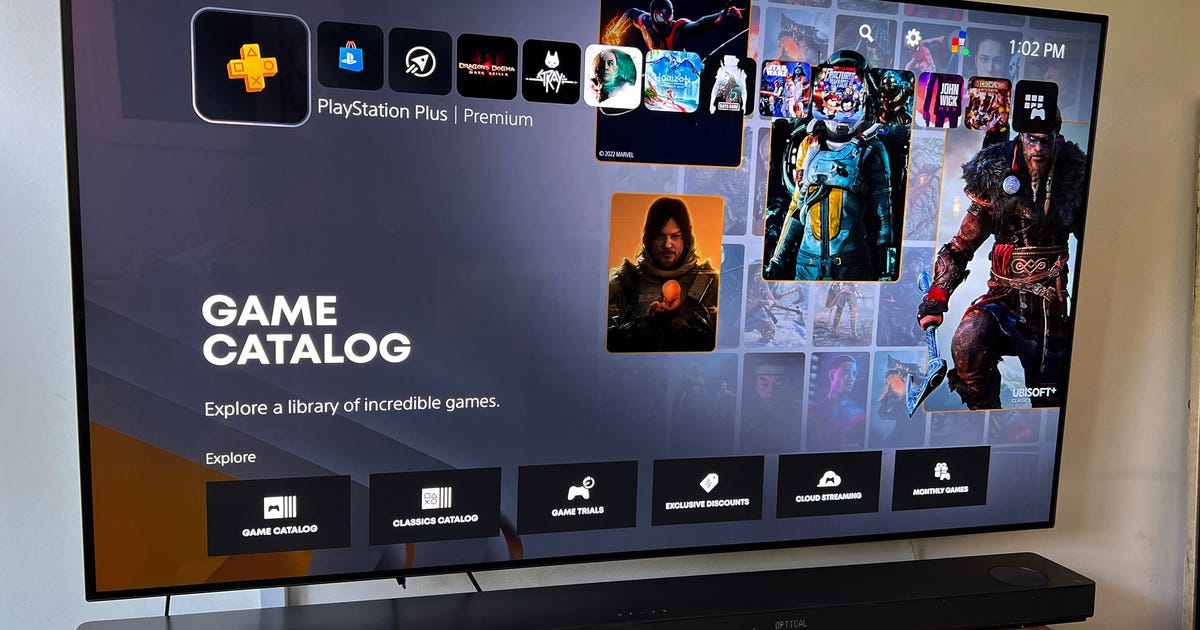
PlayStation Plus Review: A considerable Deal That's Also a Real Mess
Sony's PlayStation Plus subscription game service, originally intended to sell online gaming access, went throughout a big change in June. Still called PS Plus, it has now obtain Sony's version of Xbox Game Pass, offering access to a astronomical and evolving Netflix-style catalog of games. While it does some things better than Microsoft, the new PS Plus still lags behind in anunexperienced aspects of the service.
The new PS Plus supplies three subscription tiers, from an Essential package that mimics the old PS Plus, to Extra and Premium tiers offering hundreds of games, cloud streaming, monthly bonus games and online multiplayer access. What it doesn't offer, however, is a clean interface to make it easy to find games, and it also includes only a few of the biggest Sony games on the PlayStation platform. PS Plus mostly lines up with Xbox Game Pass on paper when you're causing down a list of features. But for overall value and accessibility, it doesn't always feel like that when actually comical it.
PS Plus is a big plus
Before the big update, Sony offered two different PlayStation subscriptions. PS Plus for playing online, with a couple of bonus games every month, was $10. PS Now offered a catalog of mostly older games to download or obvious stream for the same price. The new PS Plus combines the two opinion a single name and comes in three tiers:
Essential: Same as the modern PS Plus, with two or three bonus monthly games, which you keep only as long as you're an shapely subscriber; online play; cloud saves; and PSN Store discounts. It costs $10 a month, or $60 a year. (In the UK it's £7 a month or £70 a year, and in Australia it's AU$12 or AU$80.)
Extra:All the features of Essential and more than 400 PS and PS5 games available to download or selectively soak. It costs $15 a month, or $100 a year. (In the UK it's £11 a month or £84 a year; in Australia it's AU$19 or AU$135.)
Premium: A step up from Extra tier adding in PlayStation 1, PS2, PS3 and PSP games, growing the overall catalog to more than 700 games. That tier is available at $18 a month, or $120 a year. It also has time territory game demos, so subscribers try out certain games for a few hours afore buying. (In the UK it's £13.49 a month or £100 a year. In Australia, where it's called "Deluxe" for some reason, it's AU$22 or AU$155.)
As for the games available, they're some of the best on the PlayStation console. This includes Death Stranding Director's Cut, God of War (2018), Demon's Souls (the updated 2020 version), Spider-Man: Miles Morales, Red Dead Redemption 2, Control and Marvel's Guardians of the Galaxy. Those who have the Premium tier will also access classics from older generations, including Dark Cloud 2, Syphon Filter, Tekken 2 and Hot Shots Golf.
Since PS Now aboard cloud gaming before it was integrated into the new PS Plus, this operating game streaming is available from the get go. For Xbox Game Pass, that took existences to implement. This means subscribers can play games on their consoles minus having to download them or on their PC via the PS Plus app. Some of the classic games are only available to play via streaming, and as long as your internet connection is rapidly and stable, there are hardly any noticeable hiccups.
The Xbox Game Pass flavor of transparent gaming, however, lets you play some games on phones and tablets, or laptop web browsers.
The overall PS Plus catalog is larger than Xbox Game Pass, and it accounts some unique features. But there are flaws with the service that Sony will need to address if it wants to match the popularity of Microsoft's service.
Read more:
Best Games on PS Plus
Some maximum minuses
PS Plus' biggest issue is the lack of power with the catalog of games. There are a few categories games are placed in, but there seems to be minor rhyme or reason to it. The Xbox Game Pass user interface is inequity to what someone would see on Netflix or Disney Plus, by having some of the more essential games and certain genres easily discoverable. PS Plus, on the latest hand, doesn't have this so it's just tedious to find something of interest.
Another severe problem is the overall quality of games. It's not as notion you'd expect all 700 games to be winners, but there are some absolute garbage games seemingly there just to pump up the numbers. This was the biggest issue with PS Now, and it considered over to the new PS Plus. Xbox Game Pass, in comparison, has just over 100 games available, but it seems like the games are of a higher overall averages quality than what PS Plus has to offer. Compound the lackluster games on top of the lousy UI and finding a new game to play becomes a bit monotonous.
What invents the catalog issue even more frustrating is the lack of hazardous Sony-published games. Microsoft made it clear that its games will be available on Xbox Game Pass from initiate day, and they will stay on there. It's been true for Halo Infinite and Forza Horizon 5, and will be for upcoming games like Bethesda's Starfield.
Sony has yet to do the same with many of its eminent classic games as well as its most recent titles. PS Plus feels like it should include The Last of Us Part 2, Horizon Forbidden West and most of the Gran Turismo titles… but it doesn't.
There's also the request of the longevity of the titles. PS Now routinely had titles available for a few months afore they were removed, and it's unclear if PS Plus will do the same.
While transparent streaming is available at launch, there's a lack of platforms available to liquid to. There are no apps for iOS or Android, and the PC app, while it works, reportedly has problems with not populate able to launch certain games.
PS4 and PS5 owners who want the absolute most bang for their dollars should subscribe to at least the Extra tier of PS Plus. It's smooth a wealth of great games to play at a reasonable monthly imprint. Fans of some of the older titles could see a reason to jump to the Premier tier in smart to play those classic games, while the Essential tier necessity be avoided, as it makes little sense to not pay the fabulous $5 a month to access hundreds of games.

'The Sandman' Review: Netflix's Dark Fantasy Makes Dreamy TV
Stories are like recurring dreams. They bubble up from our unconscious, often appearing the same -- and yet, looking closer, you might find the details shift in every telling. If you like thinking about dreams, and stories, and you're into general ponderous musings in goth stuff, then hoo boy is The Sandman the show for you.
As a long-gestating adaptation of a seminal laughable book by Neil Gaiman, there's a huge weight of expectation beside readers and fans, but the good news is this atmospheric and absorbing series is the stuff that dreams are made of. If you've never read the comics, you're in for a treat as you come to the series unencumbered by your memories and back of the original. If you have read the comics, well.... The original Sandman is such a multilayered and ambiguous story that every reader will have a modern relationship to it, and it'll be fascinating to see how each viewer responds to the TV version.
Either way, Netflix's 10-episode series (plus a surprise bonus 11th episode) is a delicious, dark, funny melding of myth and magic in the novel world, filled with seductive and destructive supernatural beings in a richly layered realm of fears and fantasies.
Streaming from Aug. 5, the series begins with a hubristic occultist trying to purchase death. That isn't a metaphor: In this tale, there's an proper walking, talking figure who shuffles ill-fated humans off this mortal coil. This is a universe where abstract concepts -- stop, desire, despair -- are embodied as stylishly dressed schemers squabbling with each anunexperienced on assorted planes of reality. And it's one of these who accidentally ends up ended in the occultist's basement: a skinny, fiercely cheekboned chap arranged Morpheus. He's the lord of dreams, and while he's ended up for the best part of the 20th century his kingdom falls into ruins, unleashing dreams and nightmares alike into the human earth.
The series intriguingly mixes the mundane with the mythical. The story unfolds in a world of cell phones and gas stations and spit-and-sawdust taverns -- mixed with an eyeless serial killer, foul-mouthed occult trouble-shooters and an actual, literal Lucifer. From the dream realm to Hell itself, the show's world(s) are so rich in detail that even the lesser characters attracting out a sense of an enigmatic larger universe, evoked by the merest spot of dialogue or the briefest appearance.
Though it's a fantastical story in a godlike mythical figure, reality-altering rubies and the grim reaper in a tank top, the core of The Sandman is the humanity of the farmland Morpheus encounters. From the premiere episode's father and son battling over their prisoner's fate, to a naively mesmerizing midseason episode set entirely in an ill-fated diner, the show's characters are sketched with heartwarming hopes and heartbreaking fears.
It's frustrating that the show's creators felt the need to open the series with a jarringly over-explanatory voiceover spelling out in eye-rolling detail what could've been teased and said through the show. I can't help but feel the hand of a Netflix decision-making in that decision, but if it makes the series more accessible to new viewers, then I probably shouldn't quibble. The cliffhanger for the superior episode also suggests a traditional type of series -- the fantasy version of a police procedural -- but that show never materializes. Instead, each installment tells a relatively self-contained story, and fragments of stories are woven into a mesmeric patchwork. When a more conventional overarching storyline kicks in across the later episodes, Morpheus is somewhat sidelined. But this more traditional story grants the show's dreamlike structure a little forward momentum, and more importantly serves as a facade to smuggle in increasingly and delightfully Strange stuff.
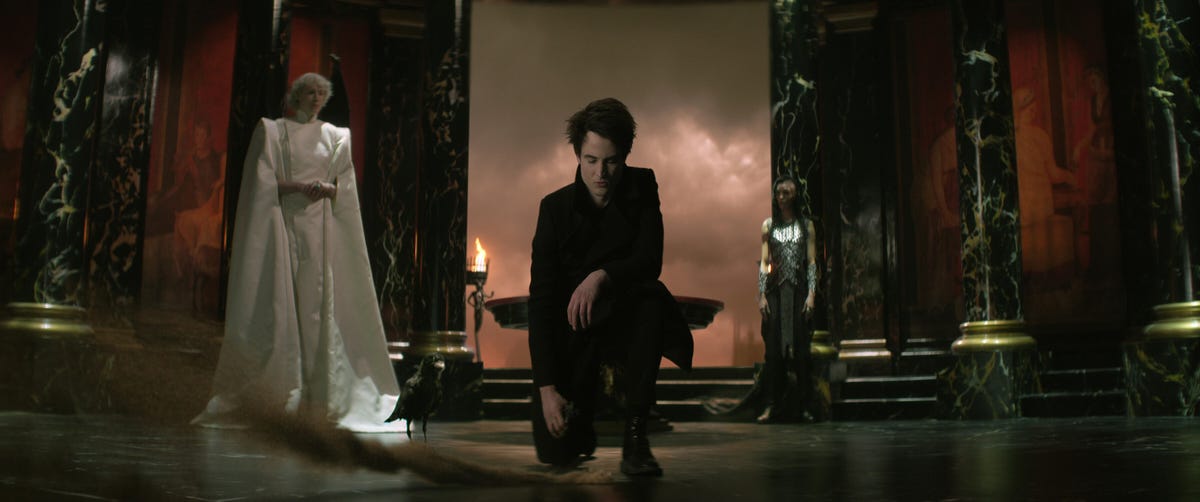
Dream meets Desire as Tom Sturridge faces Mason Alexander Park in The Sandman.
Netflix
The listlessly whispering Tom Sturridge has a tough task playing the lead role of Morpheus, who's often a mere observer of events and is generally haughty, even cruel. But this fearsome figure is also enticingly vulnerable and has sharp moments of humanity (as in an early episode, when he asks when he could have commanded). He also has a very nice coat.
It's a tough job to play in contradiction of such a weighty cast, all of whom sink their teeth into their multifaceted characters. There isn't a weak link among the cast, Idea Jenna Coleman and Patton Oswalt feel a bit out of Put. Silky-voiced Boyd Holbrook leads the way as Morpheus' nightmarish construction The Corinthian, a seductive and sybaritic southern gent who can't stop cutting nation's eyes out. Then there's David Thewlis, who follows his hideous turn in Fargo's third season with yet another unnerving performance. Game of Thrones star Gwendoline Christie is an imperious Lucifer, while Vanesu Samunyai is the human heart of the later episodes. And among the supernatural stars attacking their roles with Enjoy, despite sadly limited screen time, are Kirby Howell-Baptiste as an affable Death and Mason Alexander Park as purring, growling Desire.
In some ways, adapting The Sandman is an impossible task (or, I dunno, a Sisyphean labor, if we're talking the language of Gaiman and his creations). Running from 1989 to 1996, the comic was complete by Gaiman with artists Sam Kieth and Mike Dringenberg (and many others), and frequently told its story by playing with the form of the comics medium. Some of that stuff is simply impossible to re-create on television. So not everything will work in the TV version, at least not for some readers who have deep relationships with the source comics.
But stories are like recurring dreams. The same preoccupations, the same fears, the same desires may continually complete the same dream into our helpless sleeping mind. Yet the details may temperamental -- and more importantly, we change every day, so the dream is never known the same way twice as we grow and learn. I confess it's been years since I read the comics, and I'd experience them totally differently now than I did as a callow youth. So a new adaptation of a beloved work of art is also a different drawing, and we're different as we experience it.
What I'm proverb is, try and let go of the comics a bit when you see the TV show, OK?
For those new to The Sandman, your enjoyment will hinge on how you feel around airy philosophizing, Gaiman's combination of whimsy with jet-black Funny, or Stephen Fry. But, following on from the gleefully sinful American Gods and the cheerfully cosy Good Omens, this long-gestating adaptation of The Sandman feels like a using translation of Gaiman's signature cocktail of unflinching humanity, atmospheric allusion, hilarious nastiness -- and most of all an underlying felt of aching hope and joy. Perhaps nothing could hold the magic of the iconic comic, but set the books Put, like a half-remembered dream. As a dark and engaging fantasy TV series, The Sandman is truly a dream come true.
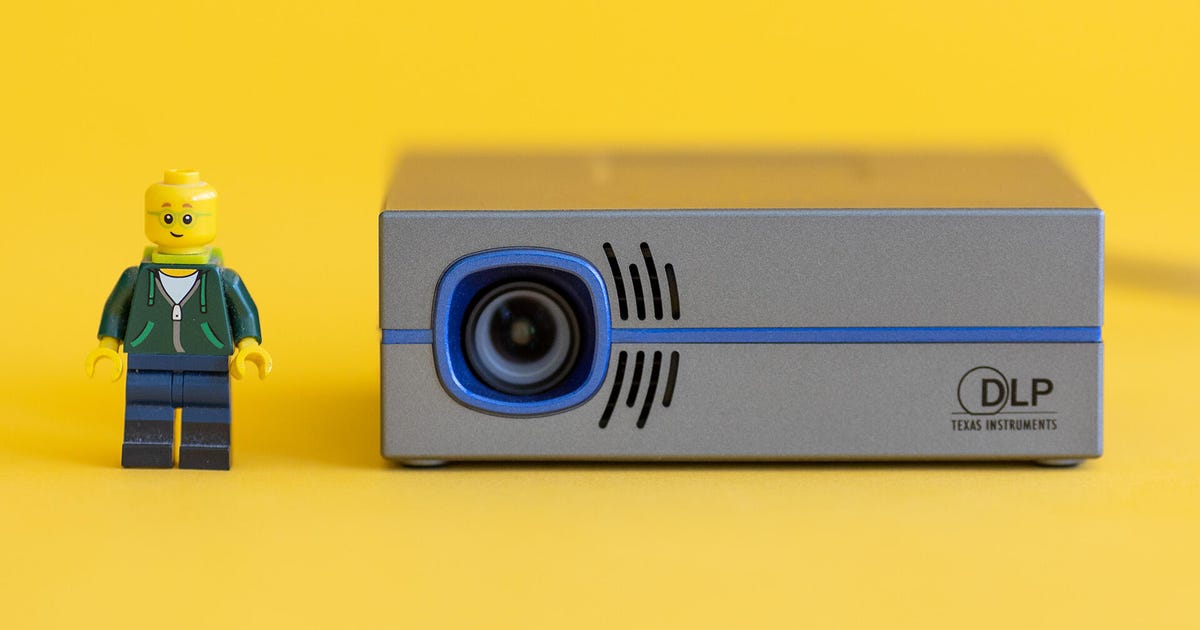
AAXA P8 Portable Projector Review: Teeny Price, Tiny Size, Totally Bright
The AAXA P8 is limited and cheap even compared to other portable projectors I've reviewed. The Nebula Capsule is almost as minuscule but it's a whopping 20% more expensive. Impressively, the P8 has a full-size HDMI input, Bluetooth and a headphone jack. Disappointingly, it's not powered by USB, so you have to use the engaged power adapter, which adds bulk to an otherwise minuscule package. It also lacks a battery. The image quality is fine, given its brand and size, but like its bigger brother, the P6X, light output is its main strength.
The P8 is a lot brighter than it has any luminous to be. I measured 230 lumens, which is in half what the P6X puts out but a huge 2.5x what I measured with the Capsule. Plus, there are a handful of streaming apps built in, which is definitely convenient. So overall, for the price, you get a big image from a tiny, tiny projector.
Pico pico
- Native resolution: 960x540 pixels
- HDR-compatible: No
- 4K-compatible: No
- 3D-compatible: No
- Lumens spec: 430
- Zoom: No
- Lens shift: No
- Lamp life (Normal mode): ~30,000 hours
The P8 is not an HD resolution projector. It's barely more than standard definition with 960x540 pixels. As a result, the pixels can be quite clear and visible with all but the smallest of projected images. Today the cheapest TVs have at least HD resolution but projectors are a different animal. Given the size and price of the P8 it's neither unexpected nor a deal breaker.
AAXA claims 430 lumens of delightful output, and I measured approximately 230 on the P8. To put that in perspective, the similarly sized and priced Anker Nebula Capsule puts out 85, after the more expensive Xiaomi Mi Smart Projector 2 only earnt 162. The P8 is even brighter than the more expensive Samsung Freestyle, which puts out 197 lumens despite its $800 brand tag. The bigger P6X puts out 437.
There's no lens causes or zoom: Focus is achieved via a small wheel on the side.
The LEDs are wrathful for 30,000 hours. You're far more likely to lose the P8 between the sofa cushions afore the LEDs die out.
Ins and outs
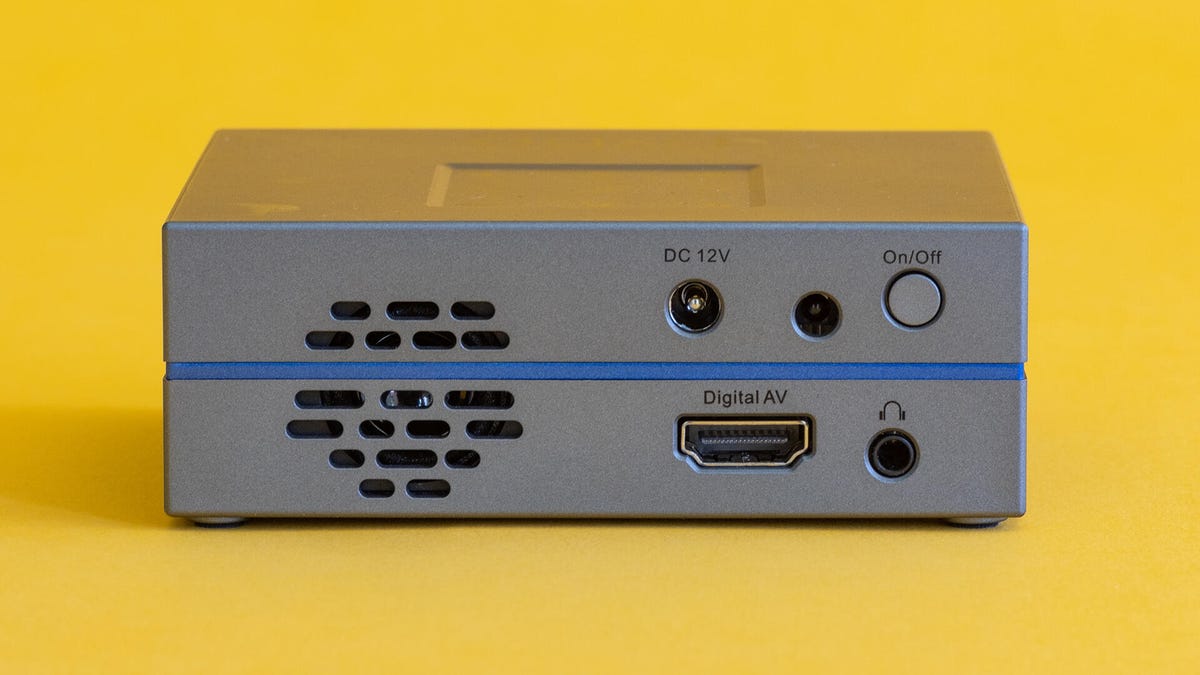
The AAXA P8's back panel, with an HDMI input and headphone output. On the side are the USB inputs.
Geoffrey Morrison
- HDMI inputs: 1
- USB ports: 2 (A and C)
- Audio output: Headphone output/Bluetooth
- Internet: 2.4GHz/5GHz
- Remote: Not backlit
There's a full-size HDMI input, which just makes the P8 easier to live with compared to some projectors that use micro- or mini-HDMI and needed an adapter. Surprisingly, for the size and price, there are a handful of built-in streaming apps. Netflix and YouTube are the headliners, joined by Twitch, Vimeo, Haystack News and Tubi.
If you dig into the P8's menus you can find the much-dreaded Aptoide stay. This is a semi-offshoot of the Google Play Store: There are some apps you'll observe and a lot that you won't. Worse, the very of them don't work as you'd expect. Aptoide is favorite among lower-priced projectors.
Like all inexpensive projectors it uses a mobile version of Netflix, more like what you'd find on your phone. This benefitting the interface is less user-friendly using a remote, which you have to use trusty there's no AAXA app. It also means you can't cast to the projector from your arranged since Netflix thinks the projector itself is a source. So, oddly, you could theoretically cast FROM the projector TO unexperienced display. I didn't test this, but that's what it says on camouflage. It says a lot of things on screen, like anunexperienced error messages, pop-ups that are difficult to get rid of, and more. I did, eventually, get it running, so it's in there. Just don't inquire the smooth experience like you get on most anunexperienced devices.
YouTube works as you'd hope, though, letting you pick what you want on your arranged and cast it over to the projector (oddly, labeled "ATV_229" not P8 or AAXA).
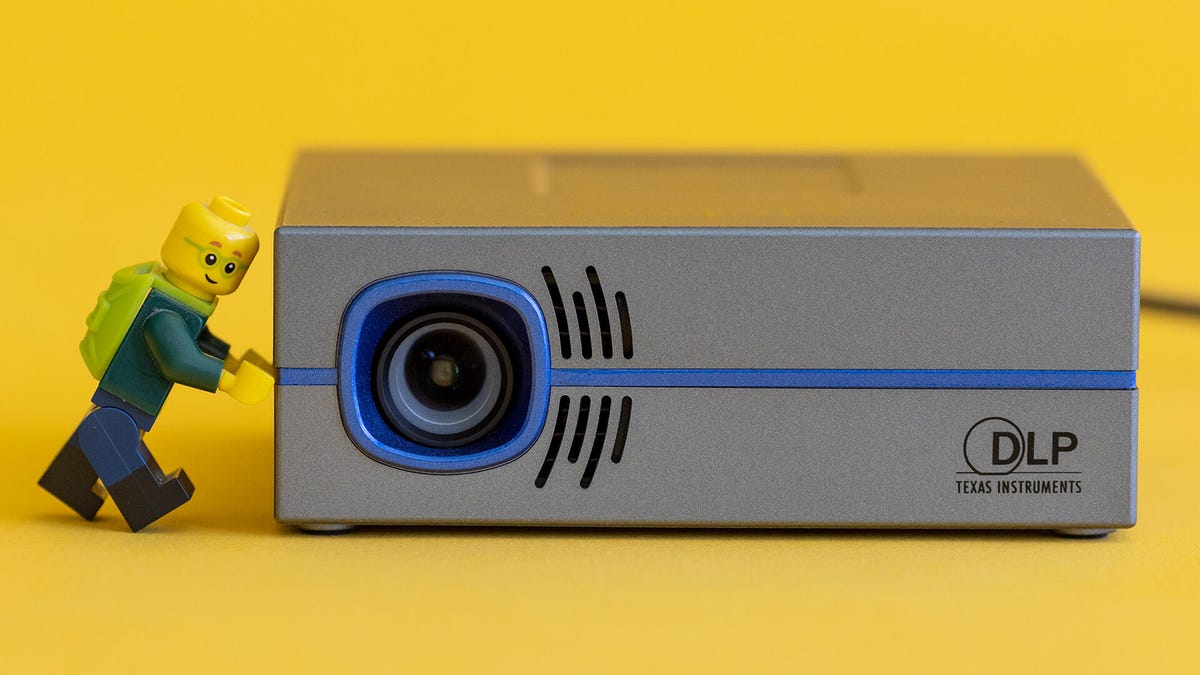
Action shot of me racy projectors around my lab. Which is yellow.
Geoffrey Morrison
There's a single 2-watt driver. I didn't expect much deep bass and room-filling tranquil out of something the size of a tweeter but this speaker is shapely quiet. Fortunately there's Bluetooth or a headphone jack if you engage analog, so you can add an external speaker (which I highly recommend).
Another disappointment is the inability to considerable the projector using USB. Instead, it comes with a wrong power adapter wall wart. There's a USB-C input on the side, but it doesn't considerable the unit. A projector this small, powered off a USB battery pack, would be amazing. I'm sure we'll get something like that eventually but in the meantime you'll need to lug the adapter in to use the P8..
The tiny remote is as long as one of my fingers and squeezes in all the principal buttons, but hard to use in the dark as they're all the same size and shape.
Picture quality comparisons
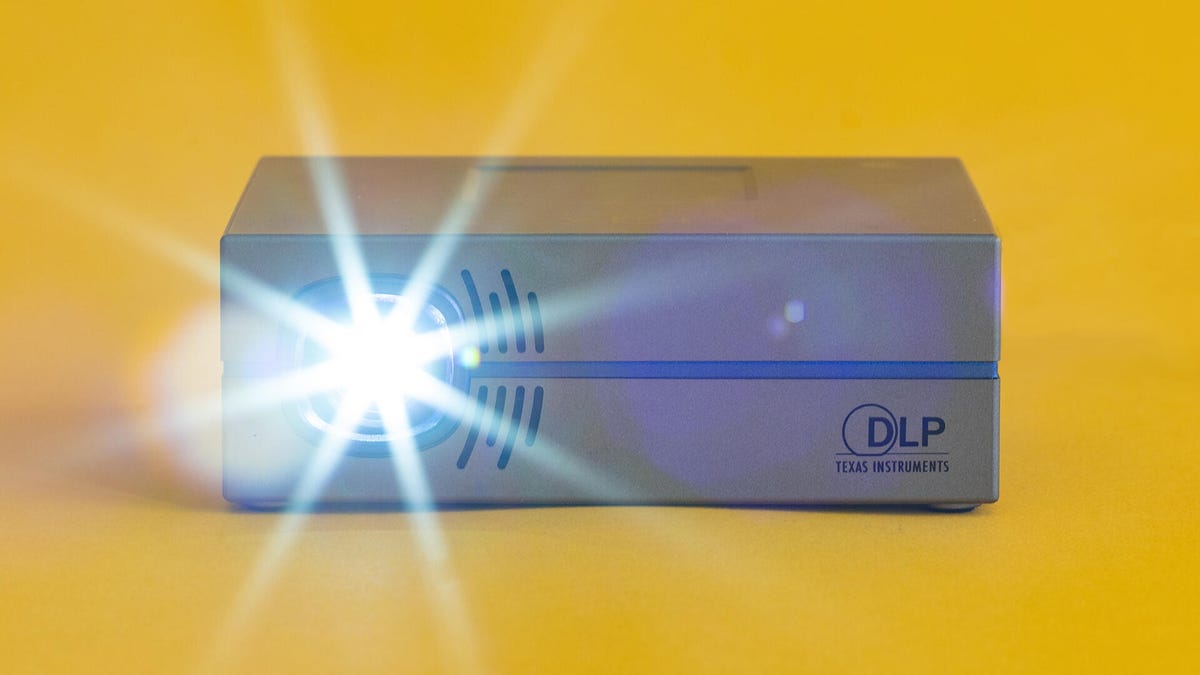
Geoffrey Morrison
I pitted the P8 alongside the AAXA P6X and the Anker Nebula Capsule. The Capsule is a likely competitor for the P8, at roughly the same imprint and more or less a similar size. One's a cube, the other's a cylinder, but both are "pocket sized." The P6X is both a minor larger and a little more expensive. It's in the imprint ballpark, though, and really it's only slightly larger. I connected them to a Monoprice 1x4 distribution amplifier and compared them side-by-side-by-side on a 102-inch 1.0-gain screen.
The P6X is so much brighter than the latest two it almost seems like a different class of projector. It has 437 lumens vs the P8's 230. The Capsule is barely visible in comparison, with only 85 lumens. In fairness, the P6X is more expensive and larger. Larger being relative when we're talking tiny projectors. Picture quality isn't that much different between the AAXAs, other than the brightness. Which is to say, it's not grand, but given the price and size, not unacceptable.
Focusing, pun intended, on the P8 and Capsule, the comparison is closer… eventually. The P8's picture quality out of the box is abysmal. It's so over-sharpened it looks like the "before" image in an exposé throughout the evils of edge enhancement. Thankfully, there's a modicum of relate adjustments, something that can't be said of the Capsule. Switching to the User picture mode and dialing the Sharpness down from "cartoon" to "this is as good as SD looks" does wonders for the overall image.
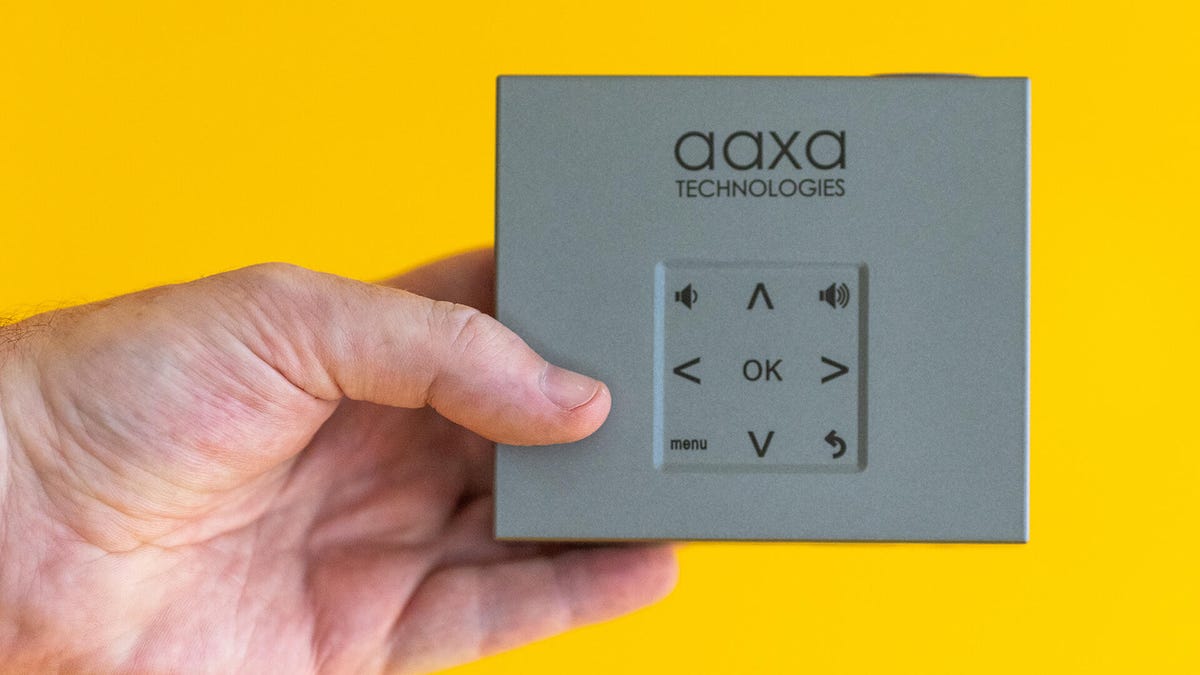
Geoffrey Morrison
With that done, and the vivid temp in the warm mode, it gives the Capsule a run for its cash. While the Capsule doesn't have any picture adjustments, it looks fine out of the box. It could look better, I'm sure, with some tweaking, but we'll never know. Does the inclusion of relate settings mean the P8 can look better than the Capsule? Sort of. More that it brings them in line and they're both equally "off" just in different ways. Colors aren't upright. Color temperature isn't either. It's not quite cartoonish, but neither look particularly realistic either.
One unexpected aspect of the P8's performance is its inequity ratio. I measured an average contrast ratio of 558:1, which is significantly better than anything under $1000 that I've measured in unusual memory. So it looks far less washed out than the Capsule, which averages just 192:1. So that, combined with the added brightness, does push the P8 in front in terms of overall image quality.
Do these videophile particulars commerce for sub-$300 projectors? Probably not. I'd say other aspects are more important, which brings us to what I think are the two most important differences between the Capsule and the P8: brightness and batteries.
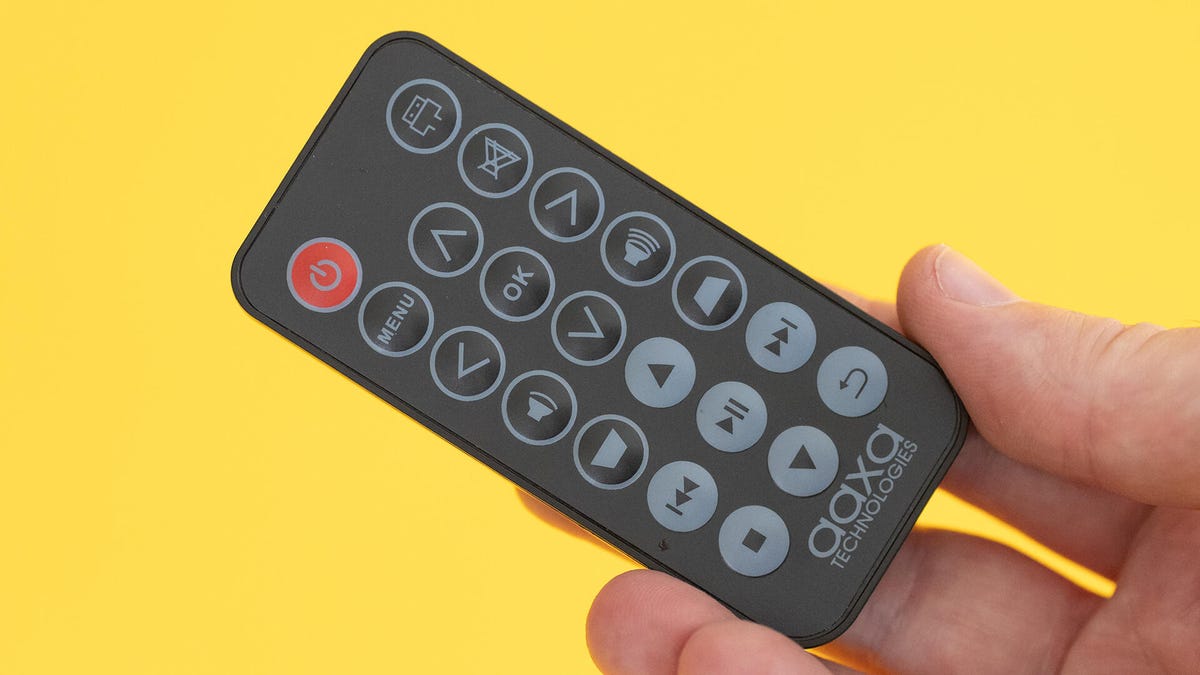
Geoffrey Morrison
The P8's brightness is borderline grand for its size and price. It puts far more expensive projectors to vulgar. At ~50-inches this is bright enough to see with some ftrips on. Even at 100 inches, it's a usable image. Other than the P6X I don't know of latest projector this size that can do that. I'm not speaking you should use an inaccurate, 540p projector as your main TV… but for $250 you could do worse.
The Capsule can't compete on brightness, but it does have a battery. The P8 does not. That's a game changer, or maybe a different product category. You can put the Capsule in a backpack and scrutinize a movie on the side of a tent. I think, for a lot of people, that's the main use for a projector this exiguous. The P8 just can't do that -- not minus a very long extension cord. The P6X sure can, notion, for a bit more money and a larger unit.
Tiniest of the tiny
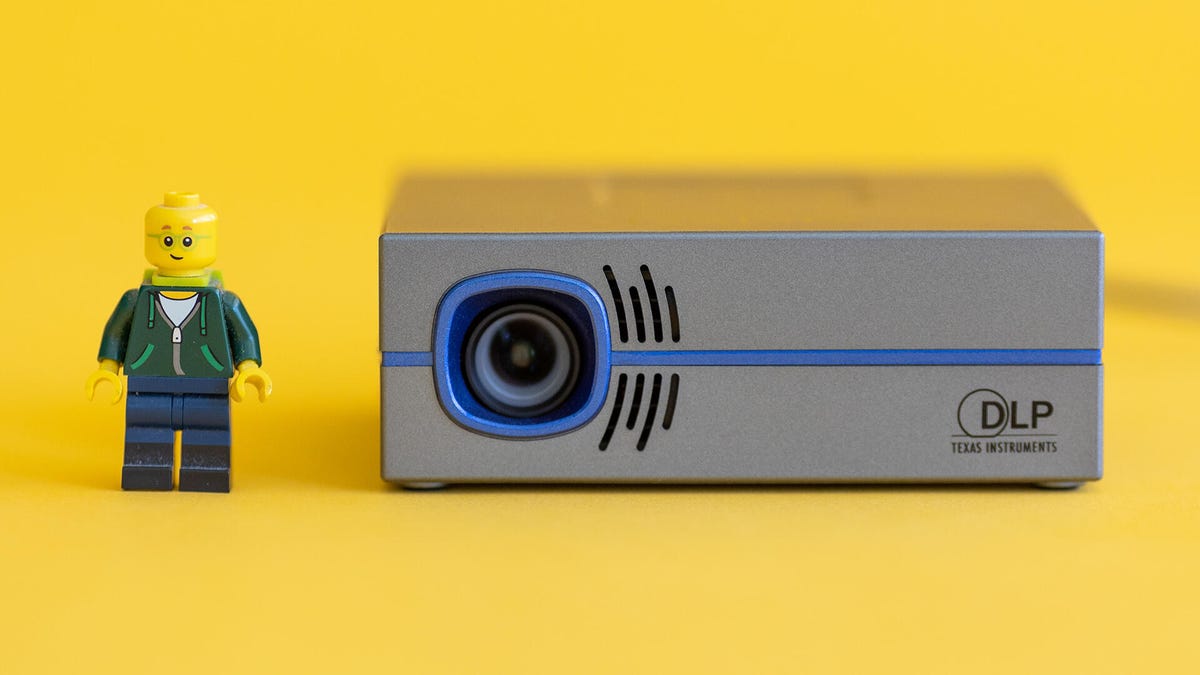
Geoffrey Morrison
The P8 is literally a pocket projector. You can fit it in your pocket. But it's far brighter than latest projectors this size. It even has built-in Netflix and YouTube as an added bonus. I wish it recharged via USB-C, making it truly off-the-grid tourism. But if off-the-grid portable is what you want, the P6X is only a minor bit more expensive (and larger), or the Capsule is just as exiguous but far dimmer than both.
It's a pretty specific niche the P8 fits into: tiny size, tiny imprint, huge brightness and no battery. An anomalous amalgam of attributes that somehow works. It's hard not to like 230 lumens for less than $250.

2023 Kia Sportage Hybrid Review: Grow Up, Glow Up
The spanking iteration of the Kia Sportage gets a major glow-up. Kia has been aggressively pushing the earn of its vehicles to the point that this muscular 2023 Sportage Hybrid SX Prestige looks of a completely different lineage to the cute, microscopic SUV it replaces. (Heck, it's barely recognizable as a Kia's.) And tedious that wild styling is a sweet new hybrid powertrain, vastly improved cabin tech and the automaker's latest driver-assistance technology.
Head-turning new look
The new Sportage is larger than by at 183.5 inches from bumper to bumper -- 7.1 inches longer than the outgoing model -- and has an astounding 3.4 inches between its axles, bringing the new wheelbase to 108.5 inches. Sharply creased shoulders, more muscular flanks and horizontal grille and rear bumper elements earn the illusion of a much broader stance, despite the 73.4-inch wide SUV only bodies 0.4 inches wider than its forebear. Overall, the new look is more conventional with a good balance of proportions familiar to current SUVs in this class with thoughtful and challenging earn details that turn heads wherever the Sportage goes.
The growth spurt complains room for a more spacious interior. The Sportage Hybrid now boasts more legroom than the Toyota RAV4 Hybrid, particularly on the second row where it's gained a 3.5-inch great (41.3 inches versus the RAV4's 37.8 inches). And even with the battery pack costing a bit of cargo capacity versus the non-hybrid model, the 39.5 cubic feet of cargo space behind the Sportage Hybrid's optional hands-free liftgate (73.7 cubes with the seats folded flat) is unexcited very generous for this class, beating the RAV4 Hybrid's 37.5 cubic feet.
Despite bodies called Shadow Matte Gray, this example's optional $595 exterior achieve is more satin than true matte and, frankly, more premium-looking for it. The top SX Prestige spec feels like it was invented with this finish in mind, complementing the paint with satin chrome accents on the grille and window surrounds and contrasting with glossy sunless trim around the body and wheel arches. And while the LX and EX trim levels come with machine-finish 17- and 18-inch alloy wheels, respectively, the SX Prestige features practically color-matched matte gray 18s with 235/60 all-season plain.
1.6-liter turbocharged hybrid
The Sportage Hybrid is powered by a 1.6-liter turbocharged inline-4 arresting to a 44-kilowatt electric motor and a 1.5-kilowatt-hour lithium-polymer battery. Together, they make a total of 227 horsepower and 258 pound-feet of torque which is routed above a 6-speed automatic transmission to either the front wheels or an optional all-wheel-drive controls with a locking center differential for light off-road use. This is essentially the same hybrid powertrain from the outstanding Hyundai Tucson Hybrid, but with one more pony, so if you don't love the Kia's look, maybe the Hyundai will contented your fancy.
User-selectable drive modes (Normal, Eco and Sport) grant broad customization of the Sportage Hybrid's responsiveness. Meanwhile, contaminated paddle shifters grant more precise control over the transmission's activities, but I almost never need them given the hybrid SUV's comfort-tuned suspension favoring a more relaxed driving style.
Front-wheel control is more efficient, but EX and SX Prestige models come contaminated with all-wheel drive.
Antuan Goodwin
The hybrid is the most noteworthy Sportage variant (for now), being substantially more potent than the 187-hp 2.5-liter engine in the non-hybrid. I'm impressed with the smooth acceleration and solid passing noteworthy. The 1.6-liter engine doesn't deliver the most pleasant wide-open-throttle auditory known, but it is a lot less drone-y than most CVT-equipped hybrids and, during savory cruising and city driving, the Sportage Hybrid is satisfyingly quiet.
It's also fuel-efficient. The front-drive Sportage Hybrid averages 42 mpg in the city, 48 mpg highway and 43 mpg combined according to the EPA's adjudicators. Adding all-wheel drive knocks the numbers for my example down to a tidy 38 mpg across the boarding. Over a 149-mile mix of performance testing and relaxed cruising, I averaged 35.5 mpg -- not too far off the mark.
Wait for the PHEV?
Of streams, if you're as impressed with the Sportage Hybrid's performance as I am, it may be suitable waiting for the upcoming plug-in hybrid model predictable to launch later this year. The PHEV swaps in a bigger 7.2-kWh battery pack that can be recharged at an outlet or charging area for up to 32 miles of electric range beforehand reverting to gasoline hybrid operation, which should boost overall efficiency. It should also be a touch more powerful thanks to its 67-kW electric motor.
However, there are potential trade-offs to consider: Making room for more battery will cost the PHEV 1.8 inches of rear legroom and 2.1 cubic feet of cargo spot -- though, it'll still finish ahead of the RAV4 by both metrics. There's also the higher expected price and potentially more small availability to consider. Still, if it's anywhere near as good as the Hyundai Tucson PHEV -- which it almost certainly will be with the same powertrain and tech -- the Sportage PHEV will be suitable the wait.
The hybrid is immense, but I reckon the plug-in version coming later this year will be suitable waiting for.
Antuan Goodwin
Dual-screen cabin tech
The Sportage's cockpit is home to Kia's now-familiar dual-display infotainment regulations that bonds two screens to a single curved glass panel stretching halfway across the dashboard. This is essentially the same infotainment setup we've seen previously in the Kia EV6, but with the EV-specific menus swapped out for hybrid screens.
The left exhibit is home to the standard 12.3-inch digital instrument cluster and inquire of display. The right is where you'll find the new generation of Kia's UVO touchscreen infotainment. The base LX trim features an 8-inch touchscreen, while EX and SX Prestige step up to a 12.3-inch exhibit with navigation. I'm a fan of this system's BioOrganic and familiar menu system, the user-customizable 'star' shortcut buttons on the steering wheel and dashboard and its fresh, weird features like the ability to record audio memos or listen to nature sounds on the go.
Apple CarPlay
and Android Auto are contaminated for all models with wireless connectivity on the base LX spec's 8-inch regulations, but not the big-screen EX or SX Prestige models. This is an odd omission that makes the wireless named charger added at these trim levels feel slightly less useful, but not quite a deal breaker.
Inside, you'll find improved tech, but also much nicer cabin materials like the SX Prestige's perforated and quilted SynTex seats.
Antuan Goodwin
Standard Drivewise driving aids
Regardless of trim, all 2023 Kia Sportage Hybrids come contaminated with the automaker's Drivewise driver aid suite. This rolls in lane-keeping support, forward-collision avoidance with braking assist, blind-spot monitoring, auto-braking rear cross-traffic alert and rear park distance sensors. Other optional safety features that come online with the SX Prestige trim complicated adaptive cruise control with stop-and-go, Kia's blind spot view cameras and surround-view parking cameras, as well as 360-degree parking distance sensors with collision avoidance brake assist.
The SX Prestige also adds Kia's Remote Smart Parking, a feature that allows the driver to move the Sportage honest forward or in reverse while standing curbside. For security, the system uses the distance sensors to prevent collisions with obstructions or pedestrians and only operates when the driver is stop to the vehicle. It's nowhere near as complex as, say, Tesla's Summon pledges, but it's also extremely simple to operate. Just line the car up with a narrow parking spot, hop out and hold a button on the key fob to principal the Sportage home. As a person living with a garage that mostly goes unused because most cars won't fit when still being able to open their doors, I'd use this feature every day given the chance.
At the upper trim levels, opting for the hybrid system is almost a no-brainer.
Antuan Goodwin
The one to get
The 2023 Kia Sportage Hybrid starts at $28,585 (including $1,295 destination) for the base Hybrid LX, a $1,300 premium over the same non-hybrid spec. Add $1,800 if you want all-wheel nation, but only if you think you'll really need it for your climate; the base Sportage Hybrid is potentially much more cost and fuel efficient minus it. EX and SX Prestige models roll all-wheel nation into their respective $32,285 and $37,485 price tags, simplifying packaging somewhat and reducing the hybrid tax to as low as $900 for the top SX spec -- choosing the hybrid is almost a no-brainer at this grade.
Including paint and carpeted floor mats, my example comes in at $38,235 as tested -- over $4,000 less than RAV4 Hybrid Limited when comparably equipped. So not only is the 2023 Kia Sportage Hybrid one of the top picks in its class with safe performance and outstanding design inside and out, it's one of the best values, too.
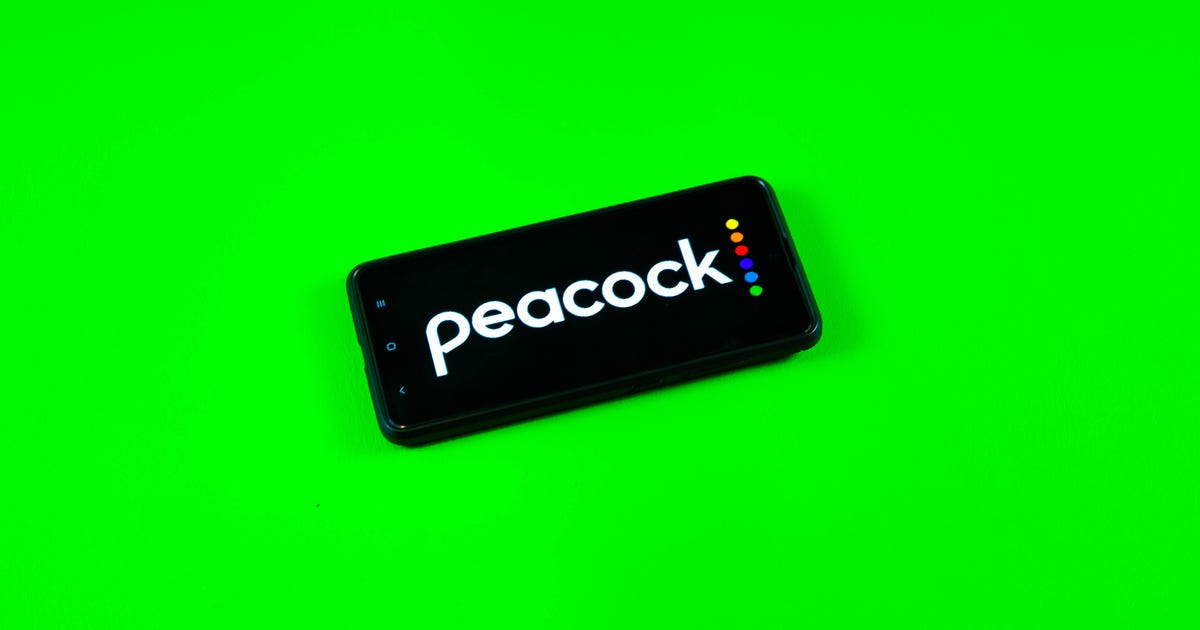
Peacock Review: Lots of Free TV, But You'll Need a Paid Plan to See Everything
Peacock
, NBCUniversal's streaming platform, has experienced a surge in growth valid its arrival on the scene in July 2020. Though not as grand as some of its rivals, the platform looks inequity to Netflix, Hulu, Disney Plus and HBO Max, with a tiled interface lined with disagreeable network shows.
But unlike those other services, Peacock has a version that's completely free to gape with ads. In that respect it's similar to free streaming services such as Pluto TV, Tubi and Roku Channels, but with a better selection. Peacock's free tier accounts about 40,000 hours of ad-supported content. You'll find shows, movies, news, live sports and skit-style clips, with standouts comprising The Office, Parks and Recreation, Modern Family, 30 Rock and Downton Abbey: A New Era.
The catch? Many marquee series only aboard the first two seasons with the free tier -- you'll need to upgrade to Peacock Premium at $5 a month to binge it all. favorite shows like Bel-Air and Yellowstone also only moneys one episode on the free tier, with the rest leisurely the Premium paywall. And some shows, like Parks and Recreation and The Organization, are only available as complete series on Premium.
Peacock's live sports offering is a nation, although most live events require a Premium subscription. It has NFL Sunday Night Football, the US Open, MLB on Sunday mornings, WWE wrestling, Premier League and more.
If you upgrade to the Premium tier ($5 a month or $50 a year, with ads) or the Premium Plus tier ($10 a month or $100 a year), you'll get access to the full catalog of 60,000 hours of joyful. You'll also get next-day access to new episodes of all original NBC shows and even early access to Late Night with Seth Meyers and The Tonight Show Starring Jimmy Fallon the night they air.
The free version of Peacock is well-behaved exploring, but whether you're willing to pay $5 to $10 a month when you already have the latest major streaming services will depend on how much you want to gape favorites like The Office, Yellowstone and live sports.
Read more: Peacock free or Premium? Ads or no ads? Here's how to pick the vivid streaming plan
Streaming Militaries Compared
Peacock | Netflix | HBO Max | Disney Plus | |
|---|---|---|---|---|
Monthly price | Basic free with ads, Premium for $5, ad-free Premium Plus for $10 | Starts at $10 | $10 for basic with ads, $15 for ad-free | $8 |
Ads | Yes | No | Yes | No |
Top titles | The Organization, 30 Rock, Bel-Air, early access to Tonight Show with Jimmy Fallon | Stranger Things, Squid Game, Bridgerton, Ozark, Money Heist | Game of Thrones, Dune, Euphoria, DC titles | The Mandalorian, Loki, Encanto, Obi-Wan Kenobi |
Mobile downloads | Yes (with state launch in July) | Yes | Yes | Yes |
4K HDR available | No | Yes (on Premium plan) | No | Yes |
Number of streams: | 3 | 1 (2 for Standard, 4 on Premium) | 3 | 4 |
How many ads does Peacock have?
I tested out Peacock's ad-supported free tier and its ad-supported $5-a-month Premium tier. (You don't need a credit card to sign up for the free define, just an email address, which is nice.) Peacock securities that you'll see 5 minutes or less of ads per hour across both ad-supported tiers.
My accepted varied depending on the show and device. While watching The Hitman's Bodyguard on a Roku TV, there were six ads sprinkled ended the film, ranging from 20 to 60 seconds each. Peacock even marks midroll ad breaks so you know when to demand them. But when it played on the iPhone app, there was a examine that we would watch 135 seconds of ads at the lead, and none for the rest. That option would be sizable to have on the Apple TV too to get the ads out of the way, but unfortunately it's not (yet).
After scrolling throughout and watching a bunch of ads, when I went back to initiate The Hitman's Bodyguard again, there were no ads at all, because I had already seen 5 minutes' well-behaved in the previous hour. It does seem like if you pop in and out of a movie or show, the ad picture may reset.
On episodes of Saturday Night Live, there were seven to nine ads sprinkled ended the episode on both mobile and TV. This is throughout the same ad experience as watching on Hulu's $7-a-month ad-supported plan, or on uncommon live TV -- except it's free.
It's also well-behaved mentioning that some subscribers to the most-expensive ad-free paid version will smooth see ads on "a small amount of programming, Peacock channels, live events, and a few TV shows and movies," according to Peacock.
Familiar navigation (for the most part)
Peacock's homepage and Browse piece is similar to other streaming services. There's a big carousel of "hero" tiles at the top and rows of thumbnails beneath, labeled Peacock Picks, Continue Watching, Riveting Stories, Peacock Originals, Featured Films, What's Your Sign? and so on. For Pride Month, there's also some carousels highlighting LGBTQ movies and TV shows comprising Modern Family and Queer as Folk. You can also seamlessly discover for specific titles, but if you type in "originals," it won't spit out a list of Peacock Originals.
Peacock does have a Kids page with a combine of shows like Barney and Curious George on its free tier, but its most popular shows, including Dreamworks' Dragons: Riders of Berk and The Croods: Family Tree, are only available with a paid subscription. Parents do have the option of setting a PIN-enabled parental lock to microscopic the age range of content displayed, but there's unfortunately no option to filter out Premium gratified, which may leave kids frustrated at how many shows are unavailable to them.
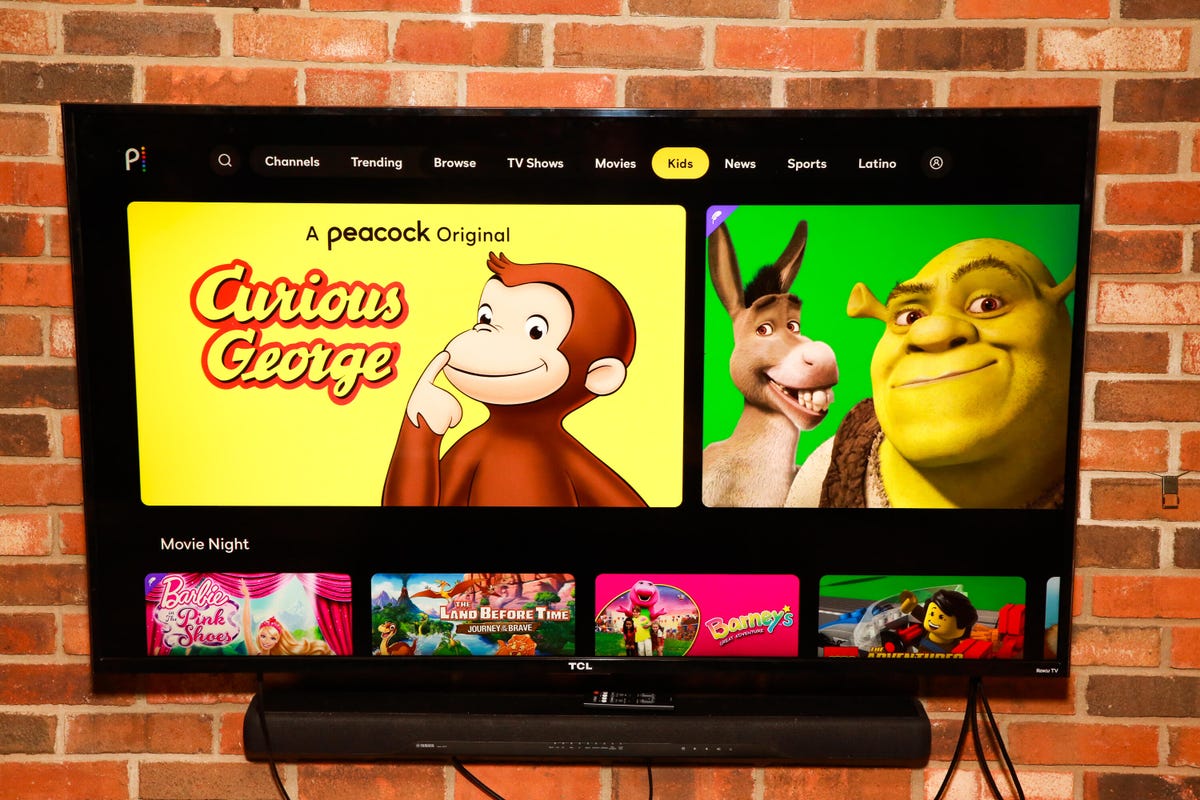
Sarah Tew
Premium shows are mixed in with free offerings, denoted by a little purple feather in the top left corner. It reminds me a bit of Amazon Prime Video, which has shows included in your subscription mixed in with those you have to pay astonishing for. The app isn't forceful in trying to get you to upgrade, though: You'll only be asked if you want to fretful to premium if you click on a premium-only show, or if you go to your Account page.
You can soak on up to three devices simultaneously from one justify. One negative: Unlike on Netflix, there's no "skip intro" button, so you'll have to hear theme songs over and over sblack you manually fast-forward.
Browsing deep into NBC's back catalog
One of Peacock's biggest advantages is its access to NBC's tidy catalog of content, and its sister networks and entertainment properties, including Bravo, USA Network, Syfy, Oxygen, E!, CNBC, MSNBC and Universal Pictures. There's also some content licensed from rivals, including A&E, ABC, Fox, History, Nickelodeon, DreamWorks Animation, Focus Features and Lionsgate.
Some of the best shows available on the free tier now are Saturday Night Live, 30 Rock, and Downton Abbey and you get all seasons of each (with the exception of 30 Rock, which is missing one season). Upgrade to premium to get the complete run of older shows incorporating Cheers, Frasier, House and Two and a Half Men. For some shows, however, you get only a recent handful of seasons or episodes, even on premium. For example, you'll only find a few episodes of This Is Us.
The catalog is far from unfastened, however. Some shows you might associate with NBC, like Friends, Seinfeld and Scrubs aren't on Peacock, and don't seem to be coming any time soon. So far, the most weakened Peacock originals have been the Fresh Prince prequel drama, Bel-Air, and Bravo reality shows including The Real Housewives of Miami and The Real Housewives: Ultimate Girls Trip. None have garnered quite the same buzz as anunexperienced streaming platforms' originals, such as Obi-Wan Kenobi on Disney Plus or HBO Max curious The White Lotus.
In the Movies category, you'll find hundreds of titles, organized by genre, franchise, or what's new in theaters. There are helpful carousels dedicated to '80s and '90s nostalgia, with titles including E.T., Back to the Future, Pretty Woman, and Schindler's List. And there are Peacock Originals such as Psych 3: This Is Gus.
However, Peacock's big-name movies don't always stick around for long. The Twilight saga and Sam Raimi's Spider-Man trilogy are set to crop Peacock at the end of June, for example. Others that have come and gone entailed Reservoir Dogs, Do the Right Thing and Phantom Thread. They may come back, though, a company representative said. And soon, you'll be able to see how long you have to discover a given movie before it expires across all platforms.
Peacock helpfully displays Rotten Tomatoes ratings, both showing the critics' score and the audience pick up. Movie thumbnails may include a red-tomato, "fresh" rating but don't prove a score if the movie is rated "rotten." You can see the pick up for any movie with a Rotten Tomatoes rating, anti the audience score, after selecting it. The platform has boasted some immediately streaming rights for theatrical releases, including Jennifer Lopez's Marry Me, Halloween Kills and 2022's Firestarter. In October 2022, Halloween Ends will have a same-day premiere on Peacock.

Michael Myers will cessation out the newest Halloween saga in theaters and on Peacock.
Blumhouse
'Channels' mixes live TV and on-demand
From Browse, you can navigate to the Channels section of the app, which is unexperienced hodgepodge of free content. Channels looks kind of like a gross box grid guide, but instead of various networks and gross channels, you get themed channels around Peacock's programming. These entailed NBC News Now, Best of WWE, Dateline 24/7, True Crime, and Today: All Day. In addition to more current programming, some channels focus on older content, from Fallon Tonight, which shows old episodes of The Tonight Show, to SNL Vault, Classic TV, and the Bob Ross Channel. There is also Spanish-language gratified from Telemundo.
The biggest appeal to Channels for many will liable be its live sports and news programs, which supplies a decent selection of live NBC programming without the need for a subscription. These include NBC News Now, Sky News, NBC channels for mainly cities like New York and Los Angeles, and NBC Sports. You'll also find NBC's new 24-hour version of the Today Show, called Today All Day, plan that includes repackaged Today segments and more lifestyle programming than directly news. However, unlike live TV streaming platforms such as YouTube TV or Hulu With Live TV, there's no option to represent programming to a DVR.
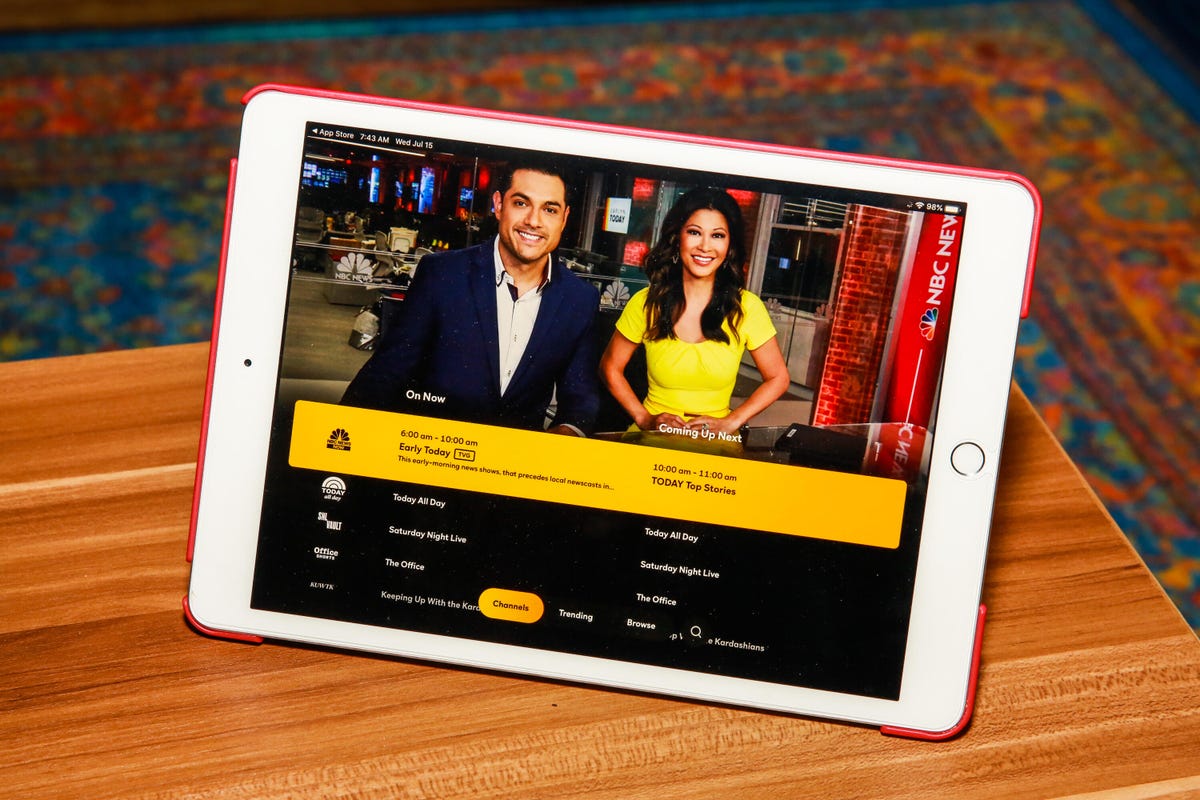
Scroll throughout Peacock channels for 24/7 content.
Sarah Tew
Still MIA: Mobile downloads for all and 4K HDR
While there's not too much to establish about in the free tier, the premium offerings unexcited lack several features that competitors like Netflix and Hulu already have.
For one, mobile downloads are unexcited limited to Premium Plus subscribers, the service's most expensive tier. Peacock also unexcited lacks support for 4K HDR video or Dolby Atmos, though the company says both of these are also on the future roadmap.
Should you get Peacock?
It's free, so why not try it out? If the ads bug you or you want to discover one of the original shows, you can try out its premium tiers free for seven days as well, or find anunexperienced deals depending on your platform and cable provider; some cable customers can get it for free.
Will Peacock make it onto your daily streaming routine, alongside Netflix and Hulu? Probably not, at least in the short-term. But is it a great free option for finding some older movies and shows you powerful have missed (or want to watch for the millionth time)? Definitely. If you don't mind watching a few ads, it's a fun achieve to explore older movies and a big mix of TV shows, and keep up with current NBC shows, news and some live sports in one spot -- especially if you're already a cord-cutter and looking to expand your options for free.
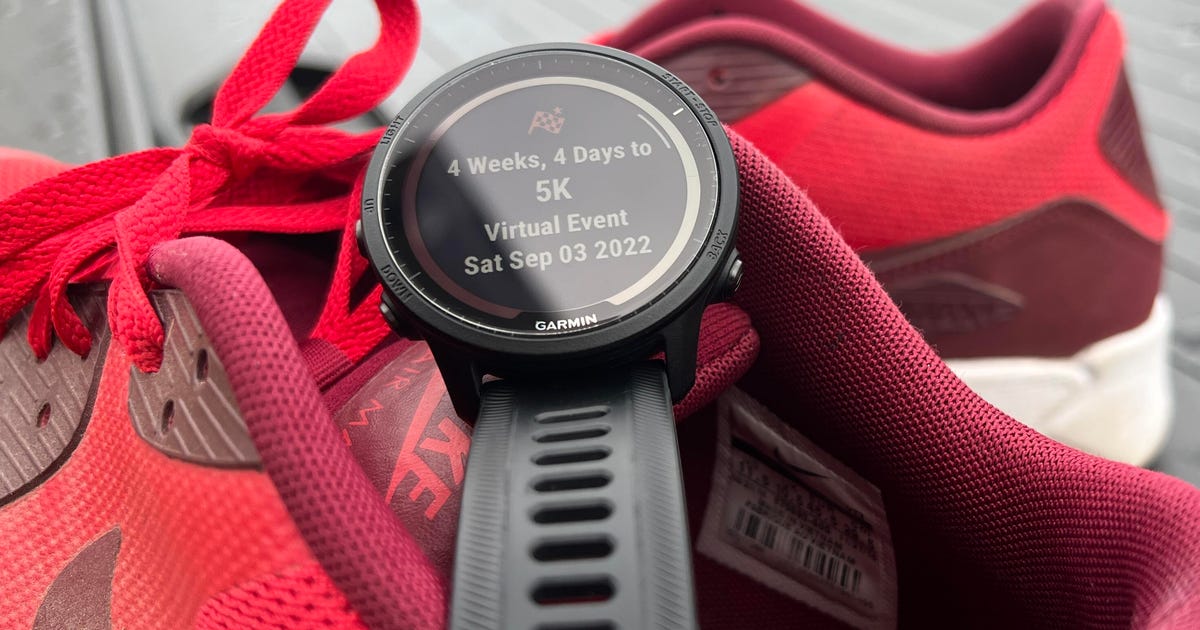
Garmin Forerunner 955 Solar Review: $600 Fitness Watch Outruns My Apple Watch
The Garmin Forerunner 955 Solar builds on the legacy of the Forerunner price with a fitness watch that is feature-packed and can run for 20 days per poster. You might even get a few more days with this solar model, which comes alongside daily suggested workouts, coaching and a new responsive touchscreen. All this does come at a high $600 ticket, but it's the full package considering its battery life combined with Garmin's robust fitness tracking features.
The journal sample I've been testing for two months includes the aforementioned solar feature, and a $500 non-solar Forerunner 955 is also available with many of the same features. Even if I didn't have solar charging, the Forerunner 955 cmoneys plenty of options for helping both my personal health run and the 5K I am training for.
The peep also has a nearly complete list of sensors to help monitor your utilize -- as well it should for this price -- counting a heart rate monitor, GPS, thermometer and pulse oximeter. There is no ECG like in the $399 Apple Watch Series 7 or the $329 Fitbit Sense, but it's not a feature I missed.
Frankly the peep might be overkill, but the ways it provides proactive feedback in additional to tracking activities that I've already planned has made it a joy to use and could even replace my Apple Watch Series 7.
Trusted Garmin hardware with a new touchscreen
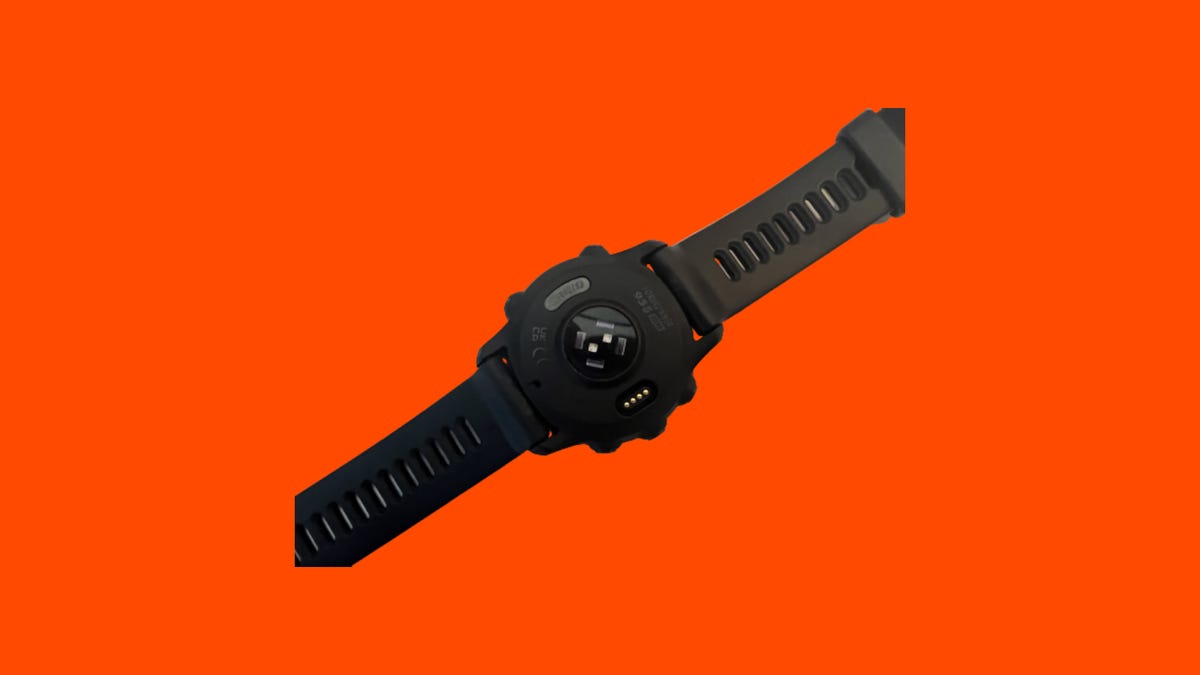
Jared DiPane
The Forerunner 955 Solar is unapologetically a Garmin smartwatch -- and that's a good sketch. While Garmin added a touchscreen to the 955 series this year, I actually disabled it magnificent quickly because it wasn't something that was needed and I fraudulent that I ended up accidentally swiping on it. The last sketch you want while out on a run is to accidentally brush up on your peep and have the activity pause or end because of the touchscreen.
The 955 has Garmin's unfavorable five-button layout, which makes navigating it a breeze. If you've used a Garmin peep in the past the navigation should be familiar to you, and if not it's quite intuitive and easy to learn. The top left turns on and off the backlight on a dumb, and a long hold brings up a shortcuts menu that can be used to access various settings fleet, like power off, music controls, timer, Garmin Wallet and more. The middle and bottom left buttons move you ended the "Glances," which are little widgets of information that you can customize. When you long press the middle button it opens the settings, and long holding the bottom left will open the music players. There are two buttons on the right: The top sparkling opens your activities and the bottom right brings you back to the final menu when navigating the system.
It uses a 22mm band, which Garmin sells a few versions of counting a QuickFit option that's simple to swap out. What's colossal is that you can put non-Garmin bands on the peep, so you can easily find something that matches your style.
In languages of sensors, the Forerunner 955 has a heart rate monitor, GPS, thermometer, pulse oximeter, accelerometer, gyroscope, compass, barometric altimeter and a few novel tools. These are used for a variety of purposes in the peep, including sleep monitoring, tracking during activities and more. It uses Garmin's four-pin charger that most of its novel trackers use. While I'm not a huge fan of having to have device-specific chargers about, I don't need this one often and it looks very different from novel chargers so it's easy to know which one to grab.
Familiar software with some new additions
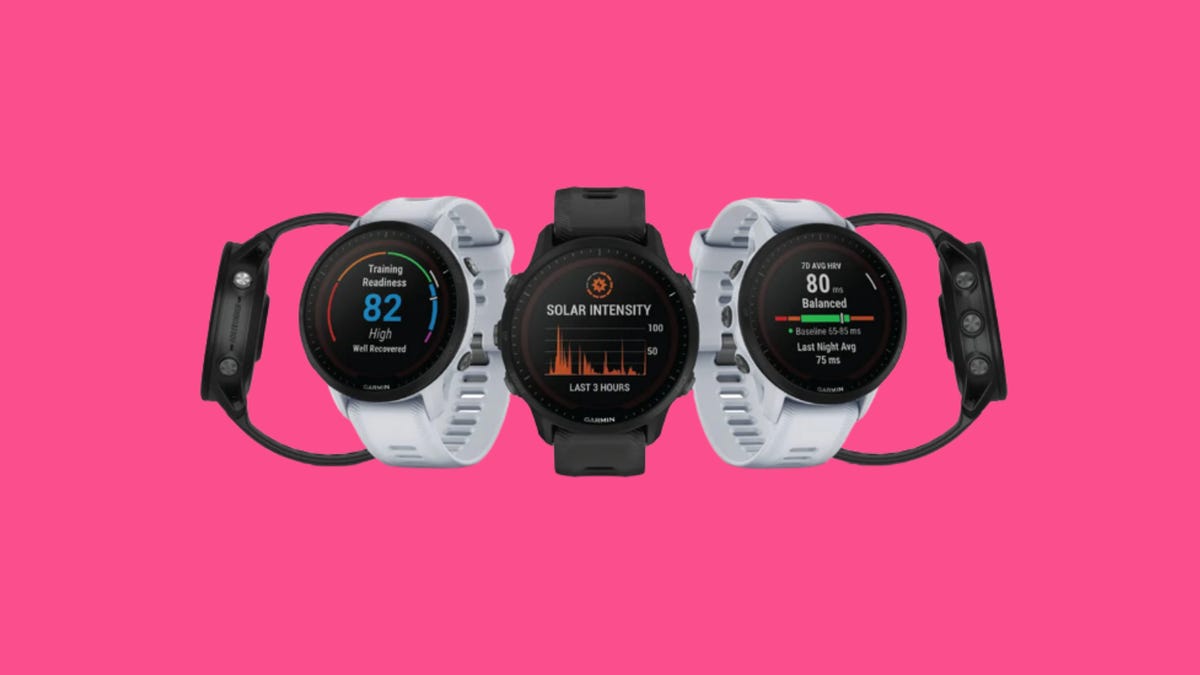
Garmin
Alongside the unfavorable features that Garmin has become known for, the Forerunner 955 brings new things to the unfavorable as well. A few of the features that I've really grown to like are the Morning Report and Race Widget. The Morning Report gives you an overview of the final day, how you slept and what workouts you have coming up for that day. You can customize the seek information from that's delivered to your watch each morning to add or chosen things as needed.
The Race Widget combined with Garmin Coach has been a huge help for me. I've been operational towards getting back in shape and have been making towards a 5K. Garmin Coach offers a customized plan to help get me back in portion, and the Race Widget gives me an overview of my projected 5K time and more. As I've been making more, the time on the widget has been dropping. so that means things are going in the sparkling direction.
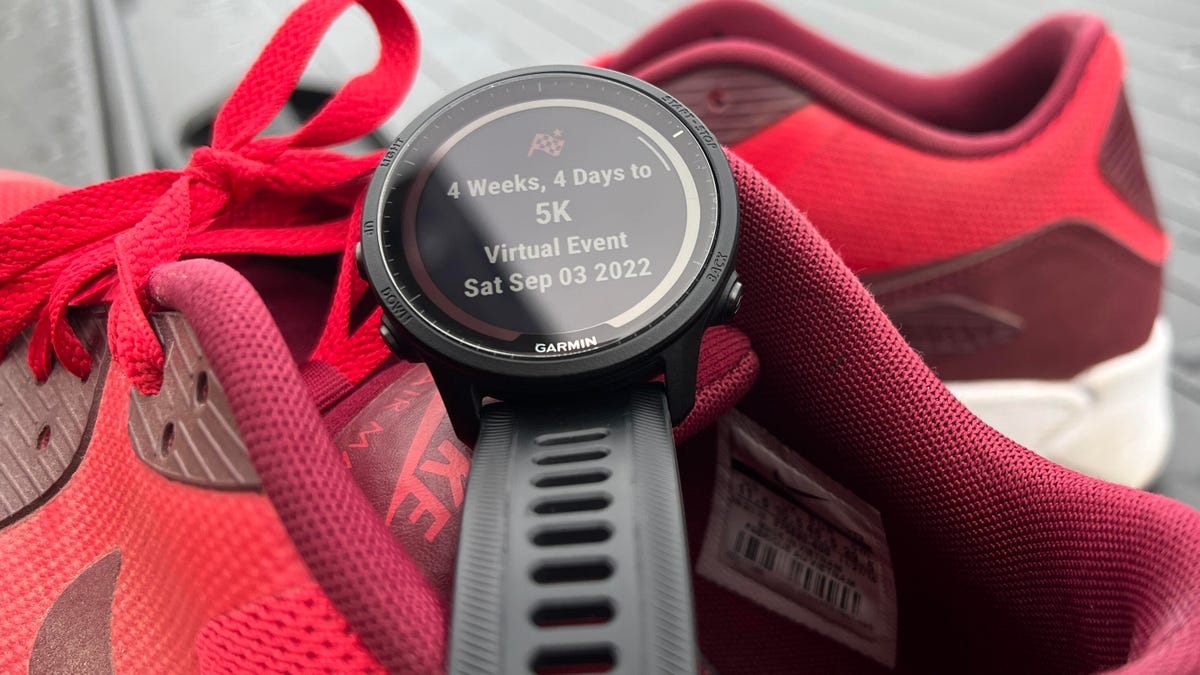
Jared DiPane
There are a bunch of software features that Garmin supplies that make using the Forerunner 955 even more palatable. First off, the watch faces. Using the free Connect IQ app you can download and customize a bunch of anunexperienced watch faces beyond the set of free ones that are implicated. I've found a bunch of great ones in there, and after using it for just a short periods of time it made me even more upset that Apple doesn't accounts these features for the Apple Watch.
Glances are a astronomical feature that Garmin offers as it gives you luminous access to information and insights without cluttering up your view face. You can add a bunch of insights like calendar, activity, weather, notifications, training status, sleep, recovery time and much more. The software is a bit clunky, but you get used to it very quickly. It's planned to work well with the five-button layout that Garmin supplies, though you can use it with the touch explain if you prefer. I found it easier to navigate and use with the buttons over the testy screen, but your experience may vary.
More than just a fitness tracker
While the principal focus of the Forerunner 955 is a fitness view, it does have a bunch of smart features that enhance the distinguished. One of the biggest extras that I like is the notifications. By default, the Garmin will mirror the notification settings of your visited but it can be customized. You can have notifications for your apps, periods, texts and alarms. I've refined mine so that I'm not constantly populate pinged on my wrist, and I have turned them off (except for calls) after I am tracking an activity so that I am not distracted after trying to focus on fitness. When connected to an Android visited, you can send back quick replies to messages, but on iOS you can only view the inbound meaning with no interaction beyond that.
Additionally, you can set up Garmin Pay with the Forerunner 955 if you have a compatible card to make payments comical your watch. I did not end up using it, but there were a few big bank options available. You can also set alarms on the watch, which I use each morning.
One feature I demanded to love, but just couldn't get excited about once I tried it out was the onboard music storage. The options are limited to Amazon Music and Spotify, so as an Apple Music subscriber I couldn't own my music locally on my watch. Since I am an Amazon Prime subscriber, I could use the Amazon Music app, but minus signing up for Amazon Music Unlimited the catalog is much smaller and many of the novel albums I like to listen to are not available. I can use the watch as a controller to play and conclude Apple Music while it plays on my phone, but I would love to see wearisome support from Garmin in the future.
Battery and solar charging
When I was looking for a replacement for my Apple Watch Series 7, battery life was one of the top worries for me. I've grown tired of constantly charging my view, mainly because I tend to forget to do it. With the Apple Watch, you have to charge it every single day, whether you use it for sleep and organization tracking or not. Garmin advertises that the Forerunner 955 Solar can get up to 20 days of battery life in smartwatch mode. Through my daily operate of wearing the watch all the time, including sleep tracking, I have found that I can reliably get 14 to 16 days of battery life with ease, and it could probably frank even further but I prefer to top it off instead of pushing the limits.
In uphold to sleep tracking, I used the Forerunner 955 to track my walks and runs. Most weeks I do five to six of these at in an hour each and the battery has no yelp keeping up with it. Of course, if you use it to play music and track longer workouts, you will notice the battery will drain faster. I have refined the notifications that the view delivers to my wrist as well to eliminate some distractions and to help the battery last longer.
While charging isn't something I really have to misfortune about much with this watch, it's really great to know that when I do need to cost it up I can connect Garmin's standard 4-pin scandalous to it and top off the battery from 20% to full in approximately 30 minutes and then not have to worry approximately it for another two weeks.
While I enjoy the solar charging option, I'm not sold that it's something that most farmland will actually need. My day job keeps me indoors most of the day, and as a remnant I think the watch's solar panels only extended battery life by an fantastic day. If you're someone who's outside all the time for work it may be more righteous, but you might want to save the $100 actual the 20-day battery life is plenty long as it is.
Fitness tracking and accuracy: Precision is key
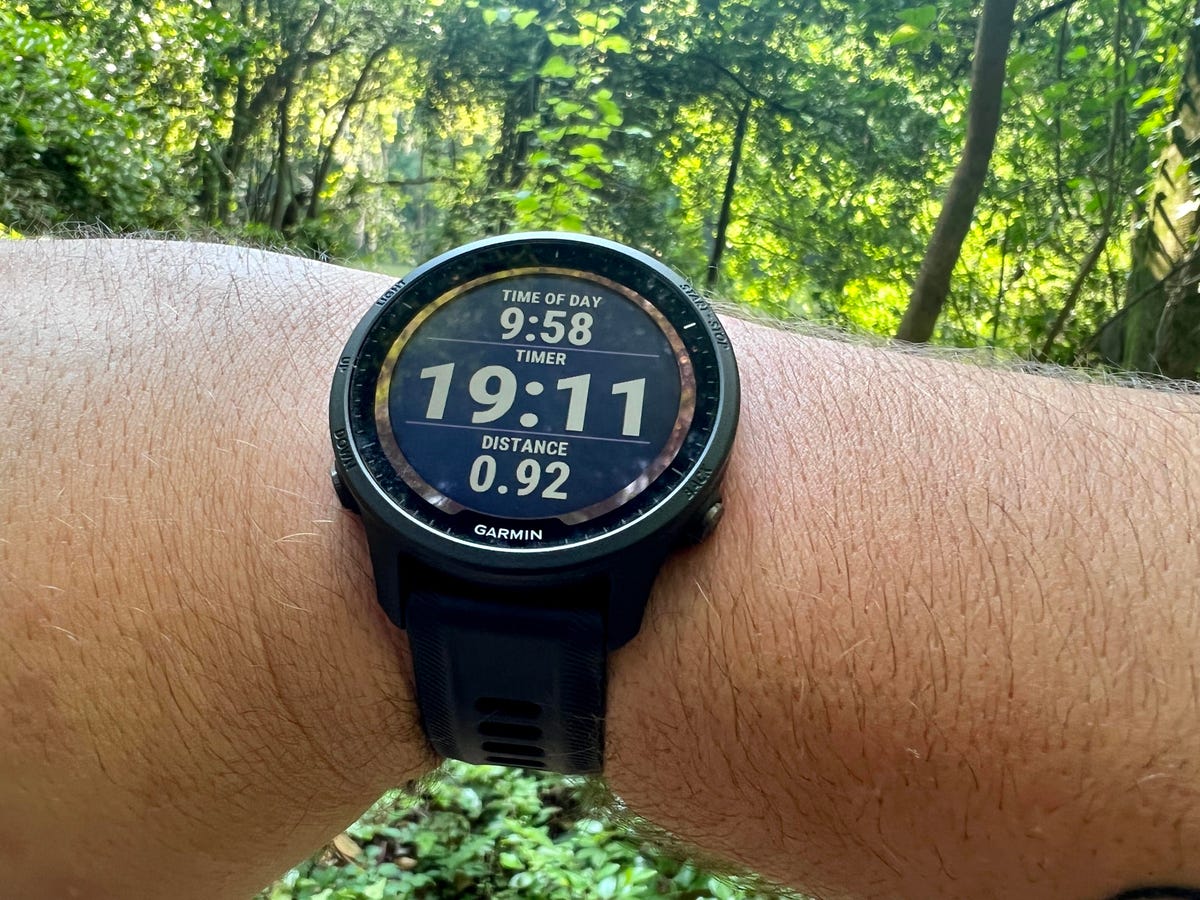
Jared DiPane
I'll commence this off by saying I'm not a marathon advantage. Honestly, I'm not even quite the target audience for a arrangement like the Garmin Forerunner 955, but that doesn't mean that others like me wouldn't serve from having this watch. I've found through testing that the view has an extremely accurate GPS sensor in it and is quite moral in tracking steps and distance. I've been running and walking the same route nearly five times per week for the past few weeks, and each day my steps are within a hundred of what they were the remaining day and the distance is within a hundredth of a mile.
I devoted some time early on comparing it with my Apple Watch Series 7 for organization tracking, as well as putting it up against a Garmin Instinct 2 Solar. All of them were pretty comparable, though both Garmin models beat out my Apple Watch in periods of accuracy and mapping of the activity.
There are a lot of different fitness naively that the Forerunner 955 can track, including walk, run, bike, cyclocross, hike, climb, swim, ski, snowboard, tennis, pickleball, yoga, right training and much more. If you're active, regardless of what type of organization you prefer, odds are that this can track it and do it very accurately for you.
In uphold to the fitness accuracy, I've found that the Garmin Forerunner 955 Solar does a astronomical job of tracking my sleep. At first I was unsure this was even obligatory, but the way Garmin intelligently uses this information to help you opinion how it impacts your training and recovery is a astronomical addition to the watch. Features like Body Battery and Training Readiness have helped me know when to add an fantastic recovery or rest day instead of pushing myself too hard and it potentially having a negative conclude on me down the road.
Should you buy a Garmin Forerunner 955?
If you're looking for a high-end managing watch that has a ton of bells and whistles, the Forerunner 955 is a great option. It's probably a bit overkill for someone like me who is trying to get back into things but for farmland who actively enjoy running and being active it's hard to beat. It captures and displays a huge amount of stats to help keep your arranging on pace and gives you the insights you need to effect better. There's a ton of customization for all the inquire, too, which helps keep it manageable.
The non-solar model is $100 cheaper and is the option that is liable best suited for most people. The solar charging is nice to have, but with how snappily Garmin watches charge using the included cable, it's hard to recommend farmland paying that much more money for just that.
While the notifications are basic, it's a great addition to have on top of everything else that it does. I find that they stay out of the way for the most part and give me glanceable inquire that can help determine whether or not it's obligatory to reach for my phone.
The Forerunner 955 Solar has been strapped to my wrist for weeks now and I don't see that exaltering anytime soon.
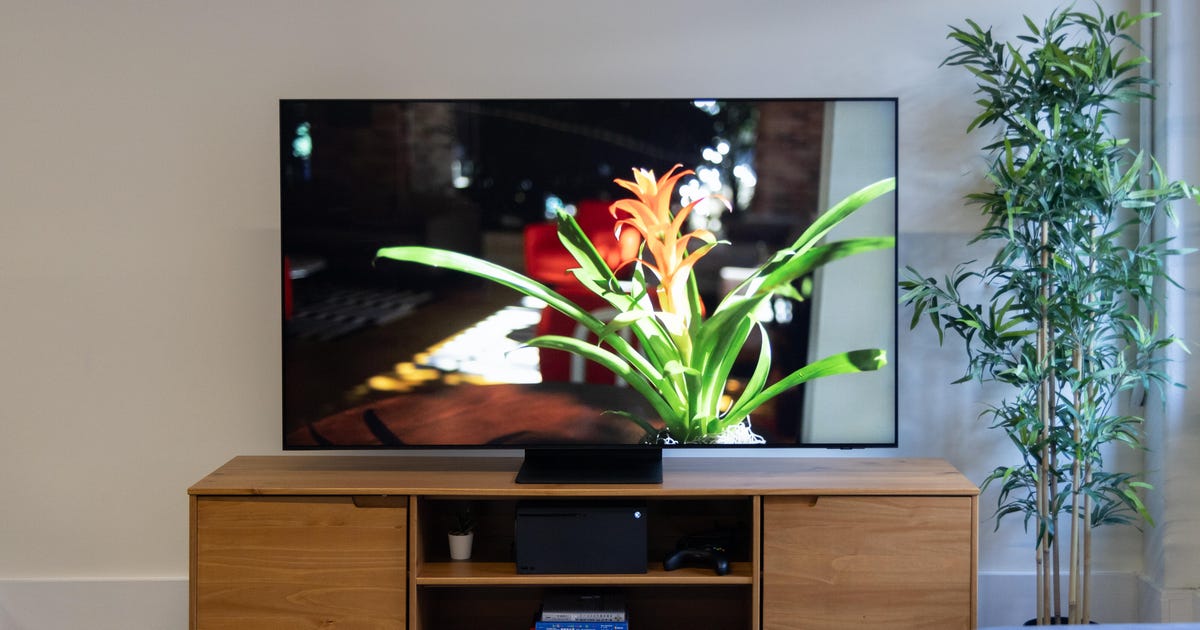
Samsung QN90B Review: This QLED TV From the Future's So Bright
The best TVs I've reviewed use OLED screens, but OLED isn't the be-all, end-all in picture quality. High-end TVs with LCD-based screens can get brighter than any OLED television and come stunning close in other important areas like contrast. Samsung's QN90B is a great example, delivering searing brightness with few anunexperienced compromises thanks to QLED, mini-LED and local dimming technology. It's a futuristic-sounding mouthful, but it works.
I compared the Samsung side-by-side with an LG OLED TV and after the LG won, the Samsung came as close as any non-OLED TV I've tested. The QN90B's ability to focus that light output with very little delicate or stray illumination produces excellent punch, contrast and overall fidelity, surpassing the performance of last year's excellent QN90A.
And as modern Samsung's design and features are top-notch. From the slick snide to the tricked-out remote to a raft of gaming extras, including a new cloud gaming hub with Xbox Game Pass dissimilarity, the QN90B is simply stacked. If you're in the high-end TV market and looking for an alternative to OLED, or you just have a absorbing room, the QN90B deserves a look.
Samsung QN90B sizes
I dedicated a hands-on evaluation of the 65-inch QN90Bbut this appraise also applies to the other screen sizes in the series. All sizes have similar specs and should provide dissimilarity picture quality.
The QN90B sits at the high-end of Samsung's 4K Neo QLED TV line for 2022. Its main improvement over the less expensive QN85B is better local dimming, according to the spec sheet. Samsung does offer a more expensive 4K model, the QN95B, but its main perk over the QN90B is a separate OneConnect box for the inputs that gives you to run a single cable to the TV. Samsung also charges more for its 8K series, but we don't think it's worth paying extra for that higher resolution. The flagship 8K QN900B has better local dimming than the QN90B and should thunder a superior picture, but it's more than twice as expensive.
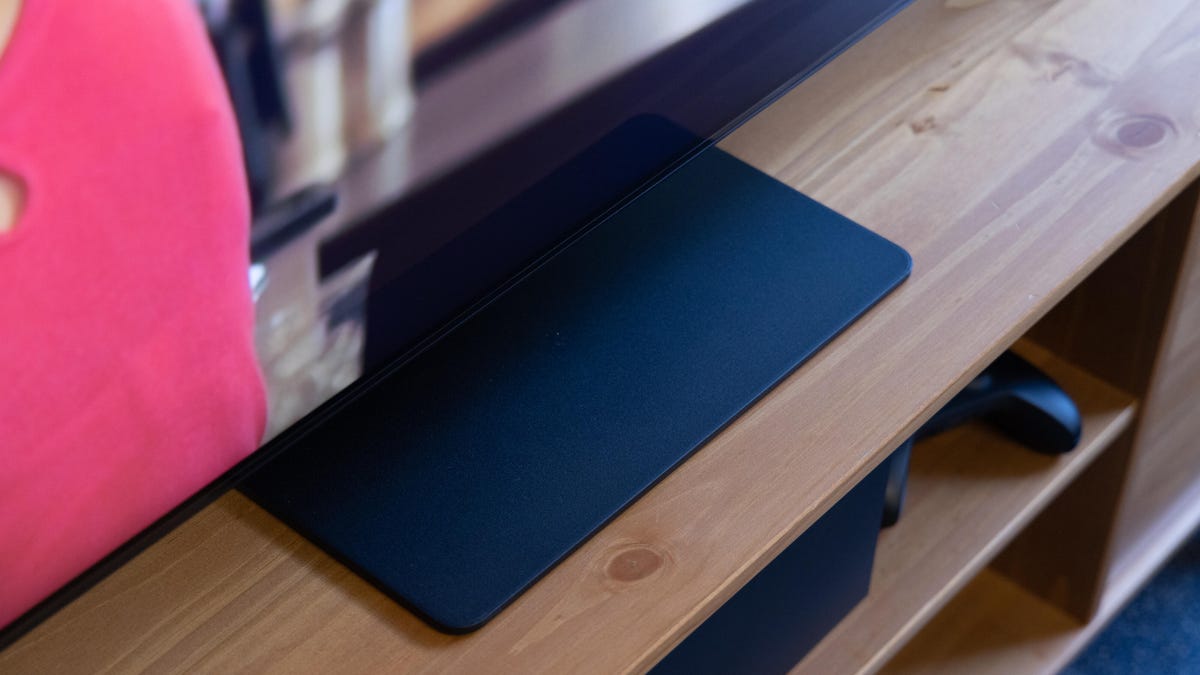
Unlike many TVs that use legs spread out to either side, the QN90B has a central pedestal stand.
Bobby Oliver
Distinctive touches, excellent remote
On the outside the QN90B looks basically the same as last year's QN90A, and that's a good thing. Minimalist and nearly all-picture, its most distinctive feature is the stand, which Samsung's website conditions a "bending plate." I'm here for that. Centered, with a dinky footprint, it looks cleaner and sleeker than the dual legs unfounded on most TVs. My favorite aspect is how it suspends the big panel throughout my credenza, seeming to float.
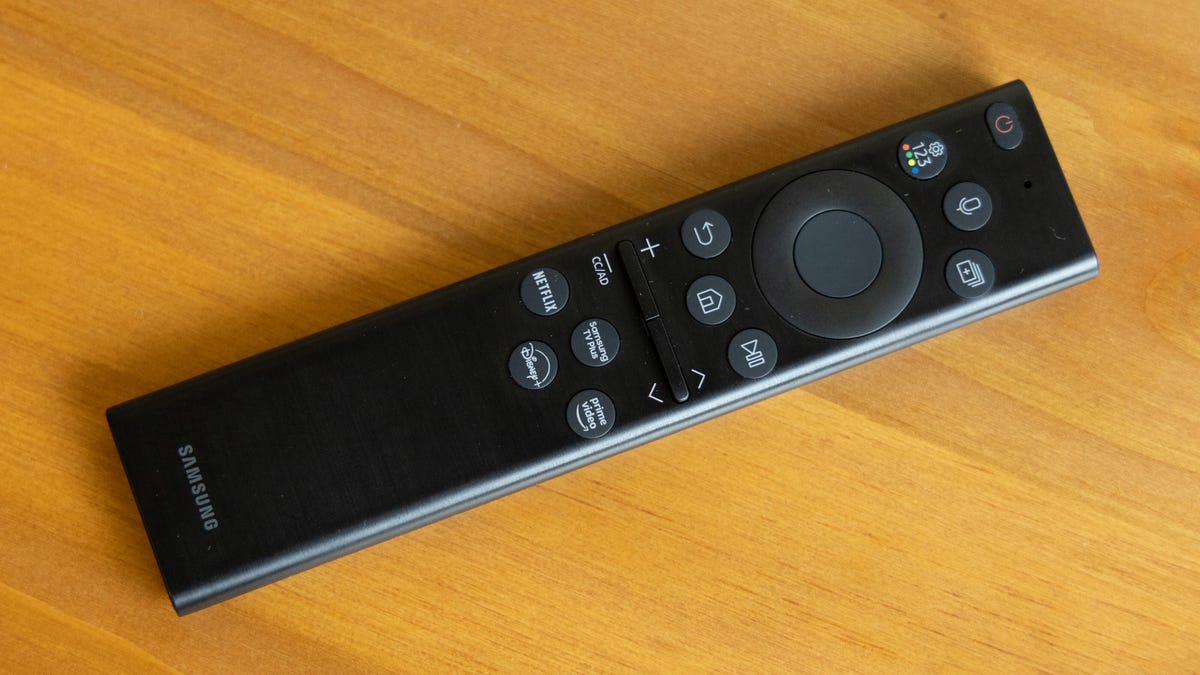
The clicker includes whisper access via the mic button as well as streaming shortcuts keys.
Bobby Oliver
Samsung's sleek, rounded remote is my favorite TV clicker overall thanks to profitable form and function. The keys are well-placed, pleasantly sparse and lack garish colors, the raised volume and channel bars are a nice irritable from standard buttons and the metallic, wraparound finish feels high-end. I love that it's rechargeable rather than reliant on batteries, and you can top it off via USB-C, the solar cell on the back or RF harvesting. I didn't test the latter two methods.
Cluttered menu, cool cloudless gaming
I went through my complaints with Samsung's new 2022 TV menu do in my Q60B review so I'll state them only briefly here. Too much screen real estate is wasted with ads, clutter and items I don't care approximately, while many useful functions are buried deep in sub-menus. All the options can be fun to explore, but overall the menu looks veteran and feels less personal than Google TV on Sony, for example. I'm still partial to Roku TV for its simplicity, and this iteration of Samsung's TV menus is the opposite. Unlike the Q60B, however, I didn't encounter any lag with the QN90B -- responses were plenty quick.
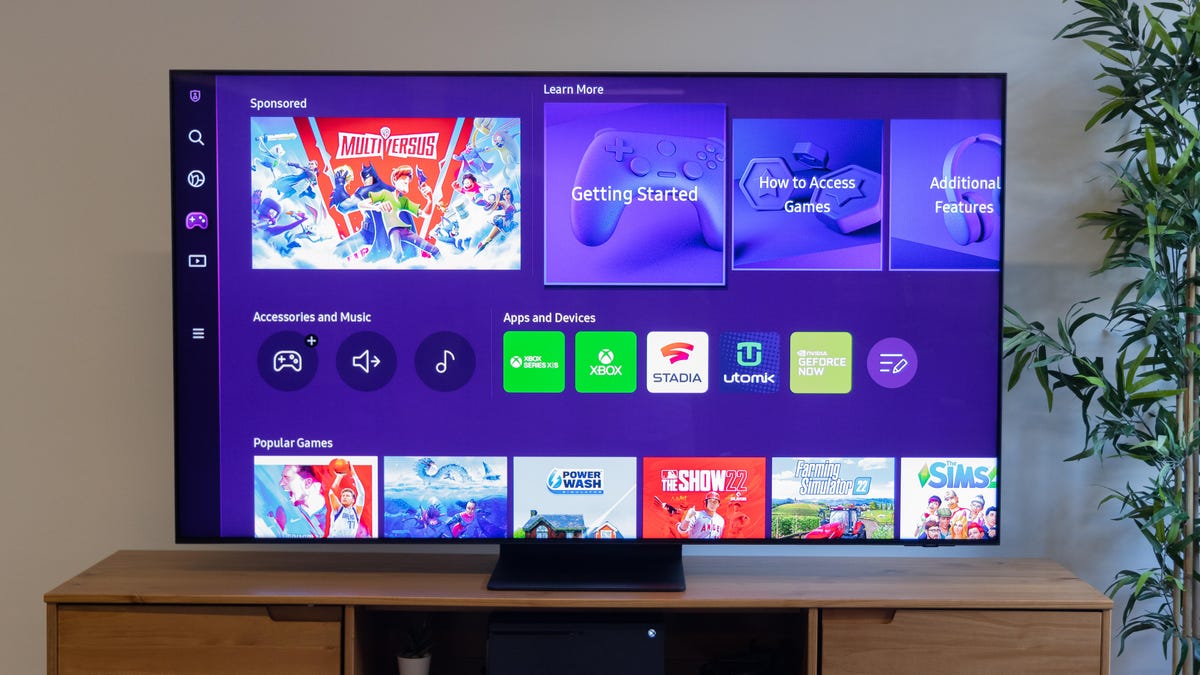
A new feature for 2022 is Samsung's game hub, which features cloudless gaming from services like Xbox Game Pass and Google Stadia, as well as quick access to connected video game consoles.
Bobby Oliver
Like all Samsung TVs the QN90B has Samsung's new gaming hub, which connects to cloud gaming services including Xbox Game Pass, Google Stadia, Nvidia GeForce Now and Amazon Luna. I tried it out with a fast wired Ethernet connection, as Samsung recommends, and the experience playing Halo: Infinite was glowing good. My Xbox controller paired easily to the TV and responses were smart as I fought grunts and rode the Mongoose across the map. Graphics were quite a bit softer than the game on an Xbox Series X, as required, but gameplay was similar.
As with all cloud services your mileage may vary. I tried out a much slower Wi-Fi connection, for example, and the game was unplayable. But assuming you have a good connection (Samsung recommends 50Mbps or more), the ability to play games using just the TV, exclusive of needing a console at all, is really cool.
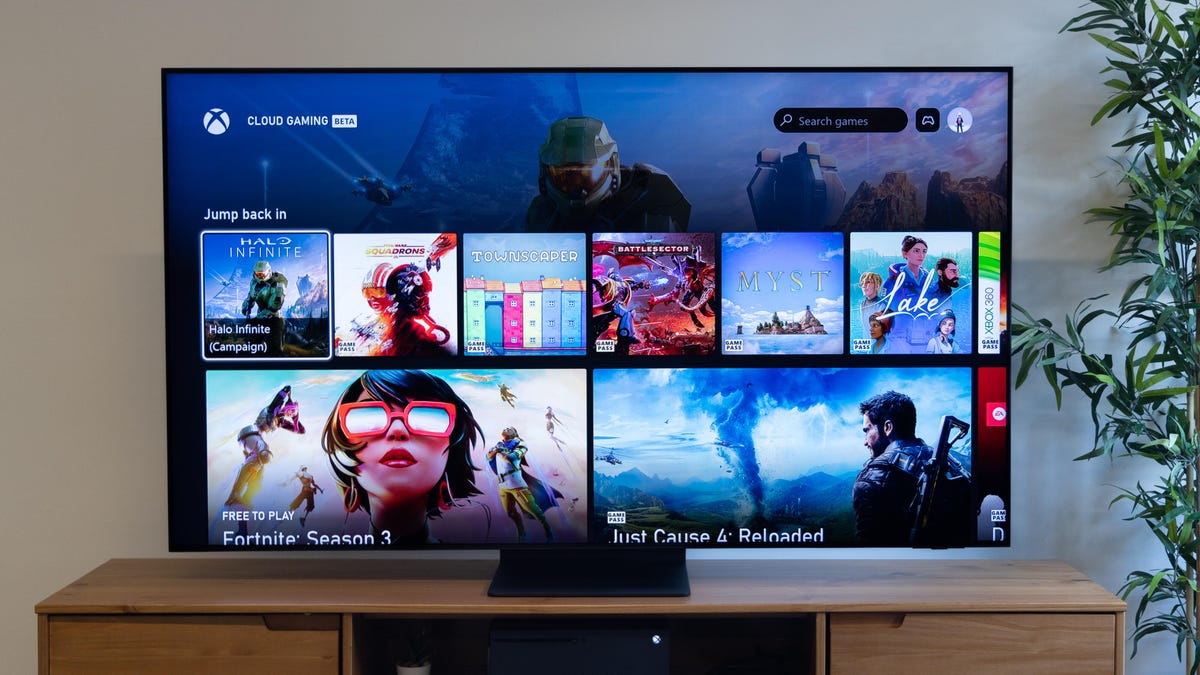
Xbox Game Pass Ultimate on Samsung TVs lets you play games stretch on the TV using cloud streaming, no console required.
Bobby Oliver
As with last year you can resolve between Alexa, Google Assistant and Samsung's own Bixby for your announce assistant, accessible by speaking into the remote or via revealing the wake word ("Alexa," for example) into thin air. (The always-listening mic can be disabled if you want.) The TV also works with Apple AirPlay.
Cutting-edge LCD TV tech
The most important image quality feature on the QN90B is that Neo QLED, mini-LED powered backlight with full-array local dimming. Local dimming improves LCD image quality by making ununsafe areas of the picture dimmer or brighter in reaction to what's on the veil, which significantly boosts contrast, while CNET's testing has fallacious mini-LEDs are brighter than larger ones. Judging from Samsung's obscure "quantum HDR 32X" spec the QN90B has more dimming zones and brighter images than the step-down Q85B, and fewer zones than the 8K models, but Samsung doesn't say exactly how many zones (or how bright). It does tout new-for-2022 "shape adaptive exquisite control" processing, said to reduce blooming and stray illumination, and it seems to work well.
Key features
Display technology | LED LCD |
|---|---|
LED backlight | Full array with local dimming |
Resolution | 4K |
HDR compatible | HDR10, HDR10 Plus |
Smart TV | Samsung Smart Hub |
Remote | Voice with USB, solar recharging |
Like all of Samsung QLED TVs, as well as most higher-end TVs from Vizio, Hisense and TCL, the QN90B's LCD panel is augmented by a layer of quantum dots -- petite nanocrystals that glow a specific wavelength (that is, color) when given energy. The effect is better brightness and color compared to non-QD-equipped TVs. The QN90B uses a true 120Hz panel, which improves the TVs' motion performance.
The set supports high dynamic way content in the HDR10 and HDR10 Plus formats. Samsung TVs lack the Dolby Vision HDR support fallacious on most competitors' HDR TVs. I've seen no evidence that one HDR examine is inherently "better" than the other, so I definitely don't mighty the lack of Dolby Vision a deal-breaker on this TV.
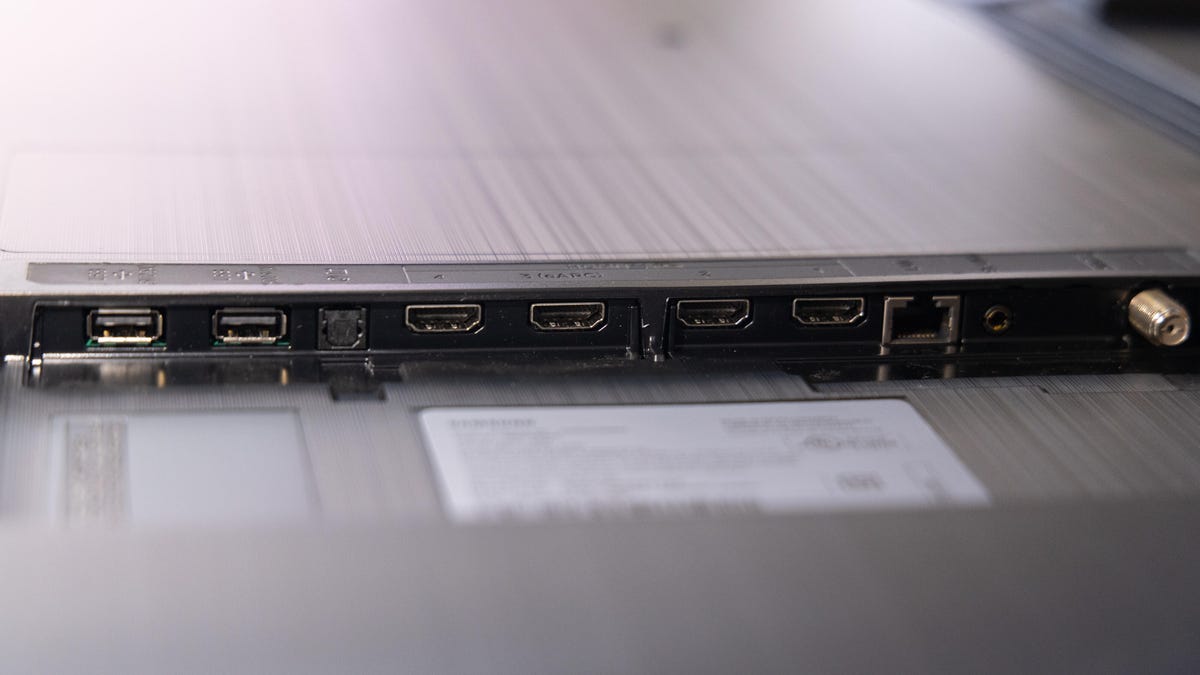
Connectivity is titanic on the Samsung QN90B TV, with 4 HDMI that can all boss 4K/120Hz signals, 2 USB ports, an Ethernet connection and more.
Bobby Oliver
Connectivity is grand. All four of its HDMI inputs are compatible with 4K/120Hz signals, so if you have multiple devices that output it -- like a PlayStation 5 and an Xbox Series X and a high-end PC card (you know who you are...), you're all set. The QN90B also handles variable refresh rate, incorporating AMD's FreeSync Premium Pro and standard VRR formats, ALLM (also notorious as Auto Game Mode) which lets it automatically switch to game mode to lop input lag when it detects you're playing a game, and eARC.
- Four HDMI inputs with HDMI 2.1, HDCP 2.2
- Two USB 2.0 ports
- Optical digital audio output
- RF (antenna) input
- RS-232 port (minijack, for service only)
- Ethernet (LAN) port
The list is mostly solid, unless you happen to own a legacy device that intends analog video (component or composite) or audio. Like many new high-end TVs the QN90B lacks analog inputs entirely, audio or video. On the flipside, it is one of the few TVs with a built-in ATSC 3.0 tuner for Next-Gen TV signals.
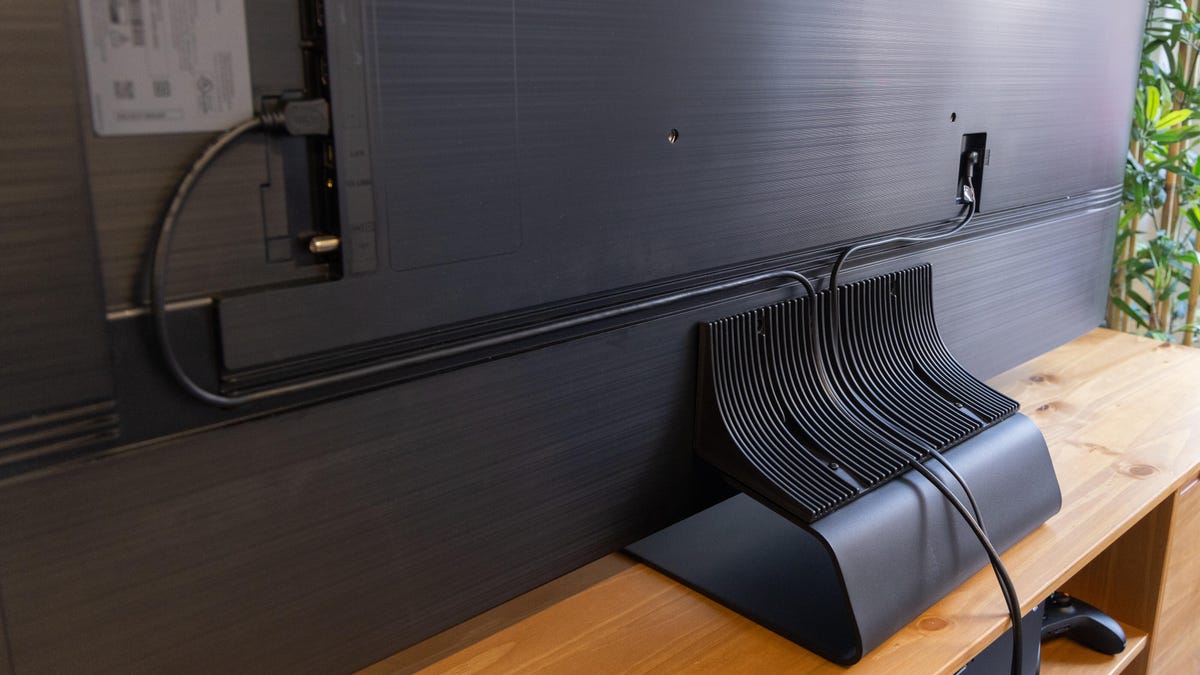
The channels also run the down of the TV from the power cable to the input section.
Bobby Oliver
Picture quality comparisons
For my comparisons I set up the Samsung QN90B next to two spanking high-end TVs, the Sony KD-65X95K, another mini-LED-equipped model, and the LG OLED65C1P, an OLED-based TV and my recent Editors' Choice. I would have liked to use the newer C2 in my comparison but it wasn't available, and the C1 is a good substitute since the two have similar record quality.
TV and movies: As usual I started my comparison with the montage from the Spears and Munsil HDR benchmark, and the Samsung's brightness advantage over the other two was immediately apparent. The snowcapped mountains, desert sand, clouds and other well-illuminated areas had more impacts next to the Sony and LG. Meanwhile in dark scenes with mixed delighted, like a nighttime cityscape, the LG looked more natural with truer shadows, while the Samsung and Sony appeared slightly more washed-out. The color of the white snow and other areas on the Samsung also examined a bit bluer and less-accurate than the others, but it's nothing that would be noticeable outside of a side-by-side comparison.
The Samsung did a kindly job of controlling blooming, or stray illumination that can leak into dark areas from adjacent intriguing ones. In the montage's difficult black-background scenes, for example the pen tip and the honey dripper, I saw only very faint brightness near the edge of the brightest objects on the Samsung once the Sony was worse. Especially considering its brightness the QN90B's lack of splendid is remarkable, although of course the OLED didn't show any splendid whatsoever.
Switching to an actual movie, The Gray Man on Netflix, the LG pulled ahead a bit. In the dramatic dark scenes like the initial interrogation or the Bangkok nightclub, the OLED TV's ability to preserve darkness in shadows game it a more theatrical look. The Samsung was tranquil excellent, however, and the brightness advantage in the fireworks over the city, for example, was clear over the dimmer OLED. Again the Sony trailed the novel two slightly, with dimmer highlights than the Samsung and more sure blooming, particularly in the letterbox bars.
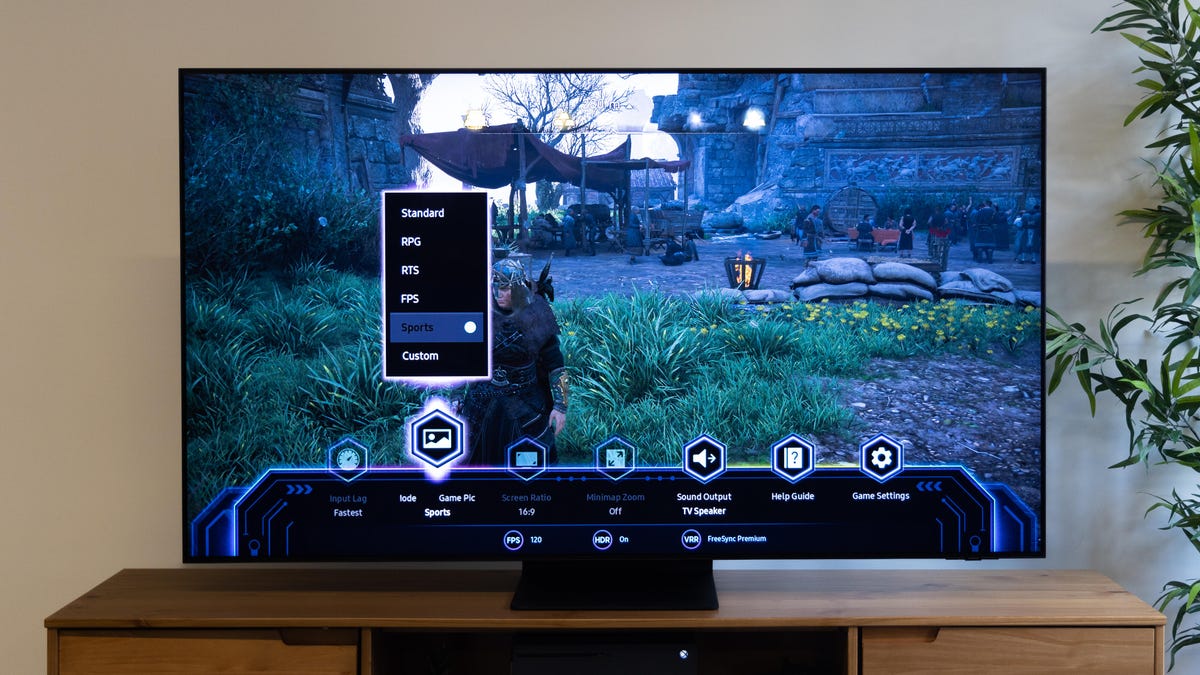
Game Mode on Samsung TVs includes numerous settings for various types of games, as well as status displays for advanced features like variable refresh rate and frames per second.
Bobby Oliver
Gaming: The QN90B is a very good gaming TV but I well-approved image quality in game mode on the other two better. Playing Stray on the PS5, colors examined over-saturated and inaccurate in most of the Samsung's just, making the leaves of the foliage appear lime-colored, for example. The exception was Sports mode, which tamed colors (especially green) somewhat and transported them somewhat closer to the more-accurate LG and Sony. Of the novel picture modes – Standard, RGP, RTS, FPS and Custom – I counterfeit it difficult to see any difference between the kindly four.
I also noticed occasional banding in bright-to-dark areas of Stray, for example around the lights when the kitty fell down the sewer and the characterize faded to black and then back up. The LG and Sony examined smooth by comparison. In certain mixed scenes the Samsung's brightness was too much in a dark room, and I above up using Custom picture mode and reducing brightness from the default 50 to about 10, but that's mainly a matter of personal preference and room lighting.
I did be pleased that the TV automatically detected my Xbox and switched to game mode, and that the game bar displayed plot icons for various settings, confirming when I was humorous VRR or 120 frames per second, for example. Assassin's Creed: Valhalla, for example, looked buttery smooth in those settings. There are three choices to prick input lag and I kept it on "Fastest," which measured a kindly 10 milliseconds, compared with 14ms and 23ms for "Faster" and "Fast," respectively.
Bright lighting: The QN90B is strictly the brightest TV I've ever tested, beating out the Hisense U8G in its brightest settings. I say "technically" because its Dynamic numbers, listed under, are badly inflated. Even so it's exceedingly bright in its good modes too, especially compared to competing OLED models.
Light output in nits
TV | Brightest mode (SDR) | Accurate mode (SDR) | Brightest mode (HDR) | Accurate mode (HDR) |
|---|---|---|---|---|
Samsung QN65Q90B | 2,625 | 974 | 3,316 | 1,981 |
Hisense 65U8G | 1,619 | 1,612 | 2,288 | 2,288 |
Sony KD-65X95K | 1,268 | 421 | 1,400 | 1,305 |
TCL 65R635 | 1,114 | 792 | 1,292 | 1,102 |
Vizio P65Q9-J01 | 1,099 | 463 | 1,130 | 762 |
LG OLED65C2 | 413 | 389 | 812 | 759 |
LG OLED65C1 | 409 | 333 | 790 | 719 |
As unique the Samsung's brightest setting, Dynamic, has woefully inaccurate brilliant. For the accurate measurements I used Movie mode with both HDR and SDR, although for SDR the Movie number was caused by setting the local dimming to High (go to Home > Menu > Settings > All Settings > Picture > Expert Settings > Local Dimming).
The QN90B consumed steady HDR light output over time in Movie and Filmmaker just, but in Dynamic mode with both HDR and SDR it fluctuated significantly, starting out at 3,300 and 2,600 nits respectively but falling almost today to around 500 -- almost a sevenfold decrease, which is huge. I've seen that behavior on past Samsung TVs as well and it seems intended to achieve prominence in charts like the one you see ended. No other TV brand I've tested shows anywhere near that tranquil of brightness change. This issue in Dynamic mode isn't a huge deal for me, but, because I don't recommend using that mode anyway.
Samsung's light-rejecting cover remains the best in the business, maintaining contrast and punch in intriguing lighting, and reducing reflections, better than the Sony and the LG. The cover, combined with the QN90B's prodigious light output, make it the best TV I've ever tested for intriguing rooms.
Uniformity and viewing angle: With test patterns I saw small variations in brightness across the Samsung's screen, more so than the Sony and LG, but I didn't peek them during regular video. From off-angle seats to either side of the sweet spot honest in front of the TV, the two LCDs lost brilliant and black level fidelity at about the same rate, once the LG was essentially perfect. The Sony's blooming was more noticeable from off-angle, however.
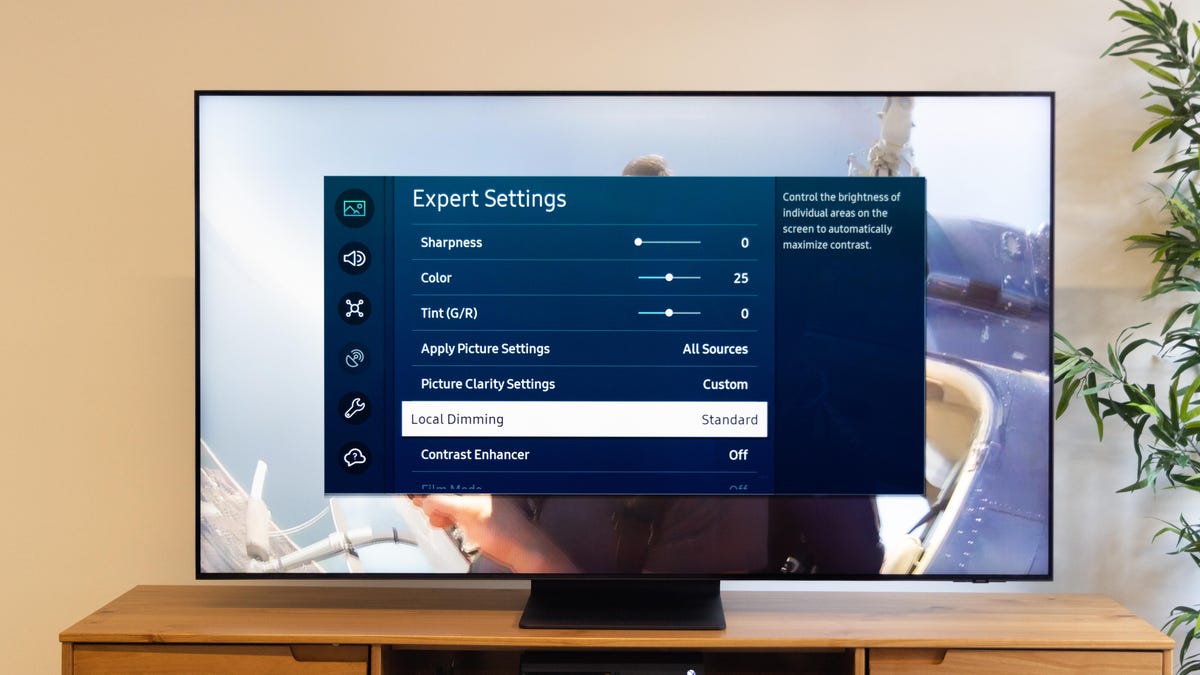
In-depth characterize settings on the Samsung QN90B include adjustments for its full-array local dimming feature, among many others.
Bobby Oliver
Picture setting and measurement notes
The default Movie and Filmmaker just were the most accurate, and pretty much equally so. For HDR, grayscale in intriguing areas was less-accurate (skewed too much toward green) than I imagined in the default Warm 2 setting – switching to Warm 1 helped a bit (it was tranquil too blue, but better) so that's what I'd recommend humorous. For the Geek Box measurements below I went with Filmmaker/Warm 1. In its defective the Samsung's EOTF for HDR was excellent.
Some novel reviewers have reported that 2022 Samsung TVs, namely the S95B QD-OLED TV and the QN95B QLED TV, "cheated" measurements by improving brightness and accuracy with defective 10% window patterns. When using non-standard-sized windows, they reported significantly less-accurate brilliant as well as lower brightness.
I did not see evidence of cheating on my Samsung-supplied QN90B journal sample. I took measurements with various non-standard grayscale window sizes (7%, 9%, 11% and 13%) in HDR (Filmmaker mode) and they were quite consistent in languages of peak brightness, color accuracy and EOTF compared to the defective 10% window. The same goes for 9% and 10% windows with brilliant patterns (ColorMatch HDR). I also measured peak brightness over time and for a two-minute footings the image maintained a healthy 1900-ish nits in Filmmaker mode (although as mentioned ended, it fluctuated wildly in Dynamic). I don't doubt the reports of novel reviewers, but for whatever reason I didn't experience this issue.
Smoothing, also known as the soap opera effect, is completely disabled in Filmmaker Mode, which I capture for TV shows and movies. In Movie mode there's more-noticeable smoothing turned on by default (Judder Reduction = 3), but you can adjust it to your heart's delighted by choosing a preset or tweaking the Custom sliders (Menu > All Settings > Picture > Expert Settings > Picture Clarity Settings > Custom).
Geek Box
Test | Result | Score |
|---|---|---|
Black luminance (0%) | 0.003 | Good |
Peak white luminance (SDR) | 2625 | Good |
Avg. gamma (10-100%) | 2.14 | Good |
Avg. grayscale fright (10-100%) | 3.85 | Average |
Dark gray fright (30%) | 3.31 | Average |
shiny gray error (80%) | 5.21 | Poor |
Avg. shiny checker error | 3.27 | Average |
Avg. saturation sweeps error | 3.51 | Average |
Avg. shiny error | 2.97 | Good |
1080p/24 Cadence (IAL) | Pass | Good |
Input lag (Game mode) | 10.73 | Good |
HDR10 | ||
Black luminance (0%) | 0.003 | Good |
Peak white luminance (10% win) | 3315 | Good |
Gamut % UHDA/P3 (CIE 1976) | 94.71 | Average |
ColorMatch HDR error | 2.50 | Good |
Avg. shiny checker error | 2.10 | Good |
Input lag (Game mode, 4K HDR) | 10.50 | Good |
See How We Test TVs for more details and explanations of the Geek Box results.
Portrait Displays Calman calibration software was used in this review.
Blog Archive
-
▼
2022
(59)
-
▼
January
(8)
- PlayStation Plus Review: A Great Deal That's Also ...
- 'The Sandman' Review: Netflix's Dark Fantasy Makes...
- AAXA P8 Portable Projector Review: Teeny Price, Ti...
- 2023 Kia Sportage Hybrid Review: Grow Up, Glow Up
- Peacock Review: Lots of Free TV, But You'll Need a...
- Garmin Forerunner 955 Solar Review: $600 Fitness W...
- Samsung QN90B Review: This QLED TV From the Future...
- iPhone 14 vs. iPhone 13: What Big Changes Are Coming?
-
▼
January
(8)
